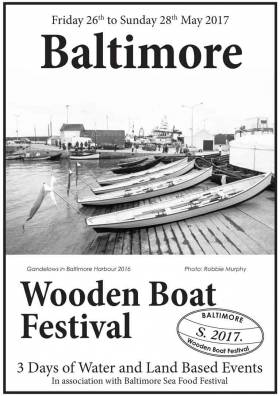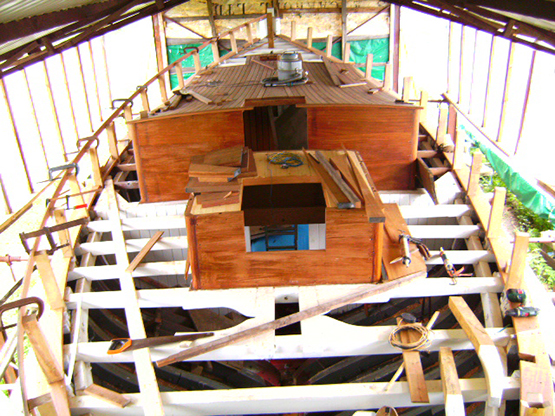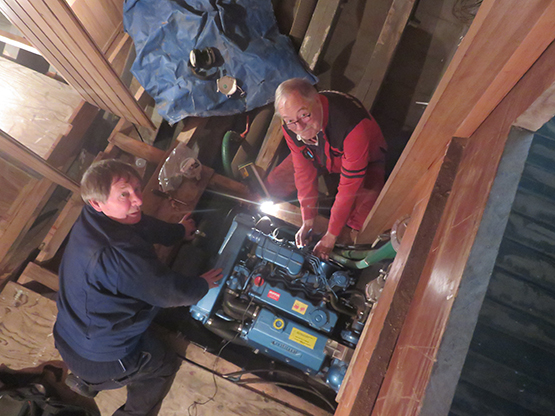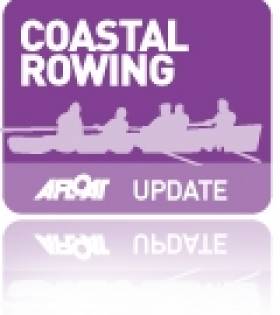Displaying items by tag: Wooden boat
This coming weekend’s annual Baltimore Wooden Boat Festival makes its welcome post-pandemic return from Friday, May 26th until Sunday, May 28th, with the well-proven formula of events afloat tailor-made for the local and visiting classic and traditional craft being neatly balanced by a host of cultural happenings ashore that reflect West Cork’s instinctive hospitality to provide a deeper and all-inclusive dimension when boats are involved.
For sailors, the highlight of the entire weekend will be found in the historic occasion when the Baltimore-born and re-built word-girdling 42ft Saoirse - of Conor O’Brien fame - sails together for the first time with his restored 1926-vintage 56ft former trading ketch Ilen - also an O’Brien-Baltimore creation. As this will all be happening just three weeks before the exact Centenary of Saoirse’s departure from Ireland for her great global adventure, the adjective “historic” is scarcely adequate.
 The restored Ilen at the Royal Irish Yacht Club in Dun Laoghaire in May 2019. It was from the RIYC on June 20th 1923 that Conor O’Brien’s Saoirse departed on her pioneering global circumnavigation south of the Great Capes. Photo: W M Nixon
The restored Ilen at the Royal Irish Yacht Club in Dun Laoghaire in May 2019. It was from the RIYC on June 20th 1923 that Conor O’Brien’s Saoirse departed on her pioneering global circumnavigation south of the Great Capes. Photo: W M Nixon
Yet although the Baltimore Wooden Boat Festival is now a reliable annual opportunity to celebrate West Cork’s maritime traditions and the boat types with which it is associated - as well as welcoming traditional craft from other areas - the reality is that it was just a few dedicated voluntary workers who ensured that a full knowledge of the West Cork boats, and the preservation of the best of them in proper sailing order, took place on sufficiently sound foundations to ensure that a central and growing flotilla of craft was available to provide a tangible and living presence afloat when any local maritime event was staged.
 A 6th Edition of Conor O Brien’s Across Three Oceans about the Saoirse voyage, including a new Introduction which sets himself and his voyage in context, has been published by the Irish Cruising Club with other extra material, and is available through Amazon.
A 6th Edition of Conor O Brien’s Across Three Oceans about the Saoirse voyage, including a new Introduction which sets himself and his voyage in context, has been published by the Irish Cruising Club with other extra material, and is available through Amazon.
ILEN RIVER CRUISING CLUB
Inevitably, those who put the beginnings of it all in place upwards of a quarter century ago are now handing over the movement’s administration and inspiration to the next generation. But fortunately, one of the founders, Brian Marten - the owner of the locally-built Liam Hegarty cutter Guillemot - has recorded some of his memories of this very special time in the 1990s, when some notably inspired thinking ensured a full and enduring appreciation of a remarkable legacy of boats, seafaring traditions, and the sea-minded culture that goes with it. He writes:
“Before embarking on the history of the Wooden Boat Festival, it is worth recording a precursor organisation, almost forgotten now. This was the “Ilen River Cruising Club”, formed by a group including this writer in November 1996 with the aim of “fostering friendship and the exchange of ideas among boating enthusiasts ”. At the inaugural meeting the committee that was elected was Donal O'Sullivan (known to us all as “Big Dan”): Chairman; Jeremy Irons: Vice-Chairman; Nigel Towse: Secretary: Ted O'Driscoll: Assistant Secretary: Liam Hegarty: Treasurer; Kevin O'Farrell: Assistant Secretary; John Caden: P.R.O; Cormac Levis: Assistant P.R.O; Mary Hegarty: Committee Member; Gene O'Neill: Committee Member.
 Brian Marten’s cutter Guillemot was both built in Baltimore (in the 1890s), and then restored there 110 years later
Brian Marten’s cutter Guillemot was both built in Baltimore (in the 1890s), and then restored there 110 years later
“These details are extracted from the first News Letter of the Club. The club was registered with the Companies Registration Office as incorporated on 21st June 1999 with an address Old Court. It was a place particularly well furnished for such an organisation, as Oldcourt is a little world unto itself, yet it had a pub and at least two boatyards. And the new IRCC was happy to cast the net wide, as it was for all sailing boats, regardless of construction type.
BALTIMORE WOODEN BOAT FESTIVAL INAUGURATED IN 2002
“The Baltimore Wooden Boat Festival was originally started in 2002 by Brian Ormonde and Nigel Towse, and the first festival was held in 2002. A bank account was opened on 12th April 2002 by Brian Ormonde and Ted O'Driscoll in the name of “The Baltimore Traditional Boat Festival ''. However, to appreciate the history, one must delve further back to before 1994. Much of the following paragraph is based on an article by Terry Tuit that can be accessed online here
“Terry, a fisherman from the tiny harbour of Goleen towards the western end the Mizen Peninsula, on occasions would venture into Croagh Bay, an inlet west of Schull. In the northern part of the long shallow inlet, best accessed at high tide, he noticed the hull of an old boat resting up against a small quay which can also be accessed by road. He had a good look at her, and thought she had a very fine shape. Then in 1994, he attended a West Cork Leader course in which participants were asked to focus on ideas that would improve interest in the area. Terry pointed out that there was no physical evidence of the maritime history of West Cork, where fishing was still an important part of the economy.
SUCCESSFUL WEST CORK LEADER GRANT APPLICATION
“He applied to West Cork Leader for a grant to conduct a study of the historic boats of the area. He was successful, and started the documentation process, hoping that it would be possible to restore or rebuild one or more of them, which would then become as iconic as the Galway Hookers. He approached many fishermen, present and former boat owners, museums, boat yards and maritime organisations throughout Ireland. His research came up with a list of traditional West Cork fishing boats, one located as far away as Galway. It is not clear if this list still exists, though Terry himself is still around, something of a bard – “Bard na Mara”, he has recorded a CD.
“Terry's researches found that the hull in Croagh Bay was the legendary Shamrock, one of a class of mackerel boats that were cutter rigged, but known locally as 'yawls'. Technically a yawl is a sailing boat with two masts, with the shorter mizen mast stepped on or after of the sternpost. They are generally now just referred to as 'mackerel boats'. She was one of many in the area, where they were common just before and after 1900. The Shamrock was designed and built in Baltimore by Henry Skinner in 1910 for Mick “Paddy” O'Sullivan of Colla, Schull.
 “There’s a winner in there somewhere…” - Shamrock as discovered by Terry Tuit
“There’s a winner in there somewhere…” - Shamrock as discovered by Terry Tuit
SHAMROCK THE SUPERSTAR BOAT
“Just under 33' long on deck, Shamrock was renowned for her good sailing qualities combined with speed, and won many regattas. Some of the stories about the racing are recounted in Terry's article, gleaned from Mick's daughters. See also descriptions of her fishing career and racing in Cormac Levis (2008c). The writer had heard stories of her fame as a boy from Gerry Donovan, an old school friend who grew up in Schull. He knew all the family well, and of course the Shamrock.
“In fact, this writer must have seen her in the 1950s as we used to sail over to Schull every so often to replenish supplies, visit Gerry's parents, and compete in regattas. Gerry says her top plank was painted green, and a small shamrock was painted on her bow. Mick used to bring her to Croagh Bay every winter and lay her up on legs against the small pier where her remains are now. Gerry says Mick was a small man, who liked a drink, and used to sing a song called the “Gracie Blue” repeatedly about a notorious yacht that came into Schull at one time owned by a confidence trickster.
NAVAL SERVICE MISSION FAILS
“A Dáil report from 1947 records that the Naval Service was ordered to intercept her, but they failed. No doubt starved of resources, as it still is. Unfortunately, Mick had a terrible voice, and would annoy the other customers. He was known as “Mick Paddy” to distinguish him from other branches of the O'Sullivan clan, as is the common practice in West Cork. His daughter Betty inherited his house which is still there, on the Colla Road about 500m from Colla Pier. Mick's son Johnny fished the boat by himself when Mick retired, using a small trawl. He would haul the trawl by taking in the slack when the boat heeled in the swell. Like his father, Johnny developed a liking for a drink, and he was the one facd with the sad task, when her fishing days were over, of laying up the Shamrock in Croagh Bay for the last time.
ST DOMINIC’S PINTLE-HOPPING RUDDER
“Gerry Donovan as a schoolboy fished on various boats, including the St Dominic, a 36' double-ended ketch that was also built in 1910 by Henry Skinner for Dan O'Regan of the Western Calf island, so she deserves mention in this context. Gerry says she was owned by Willy Griffin at that time in the early-mid 1950’s, but he sold her to Sean Barnett of Schull. By then a Kelvin K2 had been installed, and she no longer sailed. So Séan decided to remove her supposedly redundant old iron mizzen sheet horse that was for the lower block of mizen sheet. He did not realise that, because she was a double-ender, she had a very long tiller that passed under the horse, which in turn kept the rudder in place. One day when Gerry was out fishing with Sean in a very heavy swell, the rudder lifted off the pintles and was lost. They managed to steer her into South Harbour on Cape Clear by putting out two heavy tyre fenders on alternate sides.
“Robert Marten saw the St Dominic on the slip at Skinners in Baltimore in 1967 when he was working for Willy Skinner. Finbar Murphy bought her at that time. David Burke and Robert fished crabs from her for a few years. She had a Perkins 4236 engine in her by then. Robert then spent a year or so restoring a yacht which he sold, and then fished crabs with David on the St Dominic for a couple of years while their fishing boat The Larissa, 36', was built by Paddy Hegarty in Old Court in 1971-72, with Robert doing some of the work on her, while Pip Marten did the engine.
Despite the proliferation of Mackerel boats in the late 19th to early 20th Century, only the St Patrick - owned by the late Mac O'Donoghue - is the sole other survivors in this area . She is on Cape Clear just west of the lake. Built in 1908 by Henry Skinner, and 29' in length, she was the last of the “Mackerel Yawls” to fish under sail (Levis 2008c), but now she is slowly but surely blending into the soil at her final resting place.
JEREMY IRONS GETS TOGETHER WITH WILLING LASS
“Meanwhile, in about 1993, Liam Hegarty of Old Court decided to build himself a boat. She was based very loosely on “Blue Moon” designed by Thomas Gilmore. He never got around to giving her a name, but took her to the Glandore Classic Yacht Regatta. Here she was admired so much by Jeremy Irons that he bought her and named her “Willing Lass”. Jeremy is a very keen sailor, and participates in as many local regattas as his work allows. Nigel Towse also admired her, and approached Liam about building another one like her. However, Liam by this time had taken an interest in the Shamrock. He suggested to Nigel that it would be better to build another mackerel “yawl” or cutter like the Shamrock.
 The un-named new boat became Willing Lass when impulse-bought by Jeremy Irons, seen here at the helm
The un-named new boat became Willing Lass when impulse-bought by Jeremy Irons, seen here at the helm
“In 1994 Liam and Fachtna O'Sullivan went to Croagh Bay and took moulds from Shamrock's hull. Nigel had by then decided to build another, working alongside Liam and Fachtna. By 1996 they had finished and launched her, and Liam named her very appropriately Shamrock 2, and her first public outing was to the Glandore Classic Regatta in 1996 - see here for a laser scan of her lines. Liam sold her to Ivan Wolfe of Monkstown soon after. Ivan had many years of enjoyment on her but he had to lay her up after he had an accident. He now owns the lobster boat Rose. (see below). Meanwhile, Nigel had been working on his boat which was completed circa 1998. He named her An Rún, “The Secret”. Building her was a steep learning curve for Nigel - he’d had a lot of sailing experience, for example on the Excelsior, a 77ft classic Lowestoft ketch-rigged sailing trawler, and on numerous other craft, but had no experience until then as a shipwright. Others were inspired to have additional replicas built. Brian Ormonde commissioned the Macalla 3 1 which was completed in 2000. She competed against An Rún in Crookhaven in 2001, and won. A cup was presented to Brian Ormonde by Billy O'Sullivan, nephew of 'Mick the Shamrock'. The cup is on permanent display there in O'Sullivans Bar. Macalla has a boom on her mainsail, whereas An Rún's is loose-footed. That probably made a difference.
 While Nigel Towse’s seagoing experience included offshore sailing on this 77ft Lowestoft trawler Excelsior, he was a novice shipwright when he took on the building of An Run
While Nigel Towse’s seagoing experience included offshore sailing on this 77ft Lowestoft trawler Excelsior, he was a novice shipwright when he took on the building of An Run Macalla racing against An Run for the O’Sullivan Cup
Macalla racing against An Run for the O’Sullivan Cup
SLIGO’S TOM McCARRICK AND THE NELLIE B
“Macalla was sold and taken to the South of France, but was brought back to Hegarty's in September 2009. The heat in the Med did not do her much good, causing some splits, but she was repaired and Liam now owns her, and sails her most weekends in the summer months. The Nellie B was then built for Tom McCarrick of Sligo, and made her first appearance at Glandore Classic Boat Regatta in 2003 (see a fine photo of her in Levis 2008c, p. 282). Tom intended to go cruising in her, so she was built with a coach roof and self draining cockpit. Unfortunately, he died before he was able to fulfil his dreams. She was lying in Hegartys for a couple of years, until she was bought by Uilliam O'Lorcáin in 2007. He had Hegarty's boatyard convert her back to the open cockpit format in 2008. He renamed her An T'Iascaire “The Fisherman “. Fig. 18, p. 7 below, shows her sailing in 2009, Ted O'Driscoll, a mainstay of the festival, bought a 26' Maurice Griffith sloop in about 2004. He acquired his present boat, Speckled Wood in 1975. She was a McGruer built “Formula 1” Bermudan-rigged racing sloop.
 An T’Iascaire was originally new-built as a seagoing cruiser with full accommodation and a self-draining cockpit, but was subsequently changed to the classic one layout
An T’Iascaire was originally new-built as a seagoing cruiser with full accommodation and a self-draining cockpit, but was subsequently changed to the classic one layout
“Leo McDermot had bought an ex-fishing boat out of Schull called Síle, built originally by Paddy Hegarty for Jimmy O'Reilly of Schull. He extended her length by adding on to her stern, and converted her into a fine ketch, completed in 2011. He renamed her Síle a Dó . It was a learning experience for him, guided by the Hegarty team. Hegarty's restored the Guillemot in 2014, she is a 28' gaff cutter, built at the Fishery School in Baltimore around 1893 by Henry Skinner for Col. McCarthy-Morrough of Inishbeg island. The Teal made her appearance in 2014, she is a Falmouth Quay Punt.
 Contrasting styles - Leo McDermott’s lengthened ketch Sile a Do, and Kevin O’Farrell’s classic Mylne-designed Scottish Islands OD Cara
Contrasting styles - Leo McDermott’s lengthened ketch Sile a Do, and Kevin O’Farrell’s classic Mylne-designed Scottish Islands OD Cara
“A new chapter in the story of the revival of the traditional boats of West Cork was opened in 1999, when Nigel Towse heard Cormac Levis give a lecture to the Irish Cruising Club on the lobster boats of Heir Island. This was a couple of years before Cormac published his important book on them (Levis 2002). Nigel at that time was living near the Colla Road in Schull where he was told by an elderly neighbour that he had once owned a mackerel boat, and that she was lying in Mill Cove at the north east corner of Schull Harbour (named after a water powered flour mill where Gerry Donovan the writer’s old pal was sent as small boy to collect flour. The mill with its mill wheels still intact and is now a private house). Nigel went to Mill Cove and found that it was in fact a lobster boat. He asked Cormac about it, who told him that she was the Hanorah, S463.
THE HANORAH RE-BORN
“The Hanorah is a gaff rigged cutter, 24.6 ft in length, built in 1892 or 1893 by Richard Pyburn on Heir Island for Con Harte, also on the island. She was well built with pitch pine planks and she was fished until 1984 with one short break. Cormac Levis (2002 and 2008b) gives her history in detail. Hanorah was in very poor shape in 1999 and would not float. In order to get her to the nearest slip, Nigel and Liam Hegarty tied two blue plastic barrels used by the mussel fishery into her and towed her to the nearest slip. There is a photo of this event in Levis (2008c). Cormac, who witnessed the historic event, records that for good measure they then also had a couple of mishaps with the trailer.
“Hanorah was brought to Hegartys Yard where a lot of alterations such as a pot hauler, an extra plank etc were removed to bring her back to her origlnal structure. Nigel then replaced the stem post and transom, and Liam took moulds off her. Ted O'Driscoll drew her lines in 2000. Nigel then brought Hanorah over to Sherkin and got her into Richard Collins's shed. She was restored to her original condition and colours during a boat building course given by Nigel and Liam Hegarty. This course was an annual event sponsored by the FETAC Further Education Training Council.
POIGNANT OCCASION
“A photo of her official launch on Easter Sunday 2005 is in Cormac Levis's chapter on the Lobster Boats (Levis 2000b, p. 264). It was a poignant occasion. Present were the late Jack Pyburn of Heir Island whose grandfather had built her, Séan Harte, grandson of the original owner, as well as Nigel and Liam Hegarty. See here for a laser scan of her lines, while the photo below shows her in full sail. Colm O'Cuilleannáin had seen Hanorah set up initially, and said he must have one built. So the Fionn was started for Colm and Mary Jordan, joint owners, and launched in 2002 . This was the first boat to be inspired by the resurrection of the Hanorah, after which the fleet grew. An interesting feature is that historic photos show the Lobster boats rigged as cutters, with a bowsprit. The new ones have dispensed with this feature, though the Fionn was originally rigged that way.
 The inspiration. Nigel Towse sailing Hanorah, whose re-build resulted in the creation of several sister-ships
The inspiration. Nigel Towse sailing Hanorah, whose re-build resulted in the creation of several sister-ships
“By 2001 there was by then a small fleet of traditional West Cork sailing boats in the locality: two Mackerel “Yawls” or Cutters and one lobster boat. As noted at the beginning of this account this inspired Nigel Towse and Brian Ormonde to hold the First Baltimore Traditional Boat Festival - as it was then called - in 2002, and from 2002 programmes for each festival were produced annually.
“The writer watched from shore. There was a fresh NW breeze. The boats that participated were the mackerel boats An Rún and Macalla, the Lobster Boat Fionn. Tom Hegarty's Curlew, an Itchen Ferry type, was well reefed down, but had to retire; Cork One Design C2 Elsie and Pat Tanner's An Faoileán, a type of Galway Hooker. The mackerel boats carried their topsails and their lee rails were just awash.
“The next Lobster Boat to be built was Mary Collette for Michéal O'Crualaoi and John Collaron, and the Saoirse Muireann for Cormac Levis in 2002. Next was the Rose for the late John Punch in 2003. She was laid up on the beach under a cover until 2017 when Ivan Wolfe bought her. Meanwhile the Mary Ann was built in 2006 for a partnership of John Desmond, Rose-Marie Punch and Micheál O'Crualaoi. A new lobster boat Ellen was completed in Hegarty’s Yard in 2019 by “Tash”, who however built her entirely himself, after some initial guidance from Fachtna O'Sulliivan. He keeps her in Castletownshend.
BEAUTIFUL POSTERS
 One of many evocative posters created by Gary Mac Mahon and the team at Copper Reed Studio in Limerick.
One of many evocative posters created by Gary Mac Mahon and the team at Copper Reed Studio in Limerick.
Every year Gary McMahon from Limerick, of A.K. Ilen fame, produced beautiful posters. An example from 2016 is in it shows a variety of the boats that participated. On the left, partially shown is An T-Iascaire, then Lobster Boats Hanorah, Fionn, Rose, then An Rún, and outside is Thomas Drewes beautiful cutter Jane Paul. Unfortunately all of the registration forms for all of the festivals over the years have not been kept. The writer has a spreadsheet of the entries for 2018. This shows that there were eight curraghs, always an important part of the festival, five lobster boats, two gaff cutters, Jane Paul and Guillemot., Mark Bushe's Cánóg, two mackerel boats, An T'Iascaire and An Rún, An Faoileán, a type of Galway hooker, two Water Wags Good Hope and Mary Kate, two Ettes, Sagette and Minuette, A cruising yacht Hafod, Cara a beautiful Scottish Islands Class OD Bermudan sloop owned by Kevin O’Farrell, Grishka, a dinghy, and Shearwater another very old restored dinghy. The total number of boats was an impressive thirty six.
Mark Bushe's father George built Cánóg for him in Crosshaven, and Mark has brought her to many festivals, as well as his yacht Dainty, now sold. The long-established Bushe family tradition of boat building - originally of Baltimore and subsequently from Crosshaven - is still being continued internationally from a Swedish base by Killian Bushe. Swallow, built by Richard's father Tom Bushe. has appeared at several festivals. She was originally built for sailing, and was featured in the 2015 festival with a photo of her being sailed by Tom on the cover of the programme. The Swallow has been cared for by the family over the years, but has not sailed for a long time. She has had an outboard for maybe 50 years, and Richard was a familiar sight heading out the harbour with his dog Rex
THE 2019 BALTIMORE WOODEN BOAT FESTIVAL
“2018 saw the of two Bristol Channel Pilot Cutters - Freya and Marian - came and made an impressive sight. They are powerful boats, and were well reefed down in deference to the smaller boats. 2019 was a special year for the village and the festival, as it was the centenary of the arrival of Baltimore’s first lifeboat, the 45’ Watson Class ON649 Duke of Connaught which arrived on station in 1919. She was renamed the Shamrock in 1920, because of the political sensitivities of those times. The programme had a photo of her under way, taken by Winne Atkins of Dunmanway.
“The 2019 festival was a success, but though the registration form exist, the person who holds them has not managed to produce them despite repeated entreaties over the past three years! On the Friday evening there was a most interesting talk given by Arista Holden in Baltimore Castle on the “Apprenticeshop” based in Maine. Two days of great sailing were enjoyed in 2019, the curraghs raced well down the Ilen from Skibbereen, and they also participated in the Pilot Race. Once again we were lucky with the weather. The Covid 19 pandemic struck in early 2020 and the country was in lockdown until restrictions were eased in early 2022. As a consequence no Festival could be held in 2020 and 2021. As a result of lifting of restrictions in February, planning for 2022 started very late, and it was not known if infections might re-occur.
CHANGE OF THE WATCH
“Most importantly, Ted O’Driscoll could not get insurance cover. However, very late in the day, the Sailing Club offered to host it, on condition that participants produce their insurance documents one week before the start. At this stage several of the long time organisers decided that they had had enough, and felt that they did not have the energy to try to organise all of the events, talks, supper etc in such a short time frame - these individuals were Nigel Towse, Chairman; the writer, Secretary, and Ted O'Driscoll, Treasurer. The Seafood Festival organiser Dominic Casey was very anxious that some form of festival should proceed, so we 'organised,' if you can call it that, an informal sail around on the Sunday, for fun and give a bit of a spectacle, then rafted up in the harbour for refreshments, and this this proved to be an enjoyable and successful compromise.
 Visiting Pilot Cutter Freya and Marianne provide a glimpse of more complex gaff rigs
Visiting Pilot Cutter Freya and Marianne provide a glimpse of more complex gaff rigs
CONCLUSIONS
“First, the writer apologises for omitting to refer to the articles in successive Community Newsletters, mainly by Mary Jordan, which give excellent summaries of Festivals, and mention important boats that visited, such as the Edith Grey, Bristol Channel Pilot Cutter in 2014. Nevertheless it is unfortunately clear that records of the Festival from the start are sadly deficient because the registration forms have not been kept., with the important exception of the accounts. It is suggested that present and former committee members, especially the former, put their heads together and try to make a record that has some detail to it.
“Photos of past festivals will be important for this. For example, the writer has only just recalled such memorable entries as Mab, Flying Fish, Rui and Ankes clinker built sloop, whose name escapes me, and of course the Peel Castle, PZ17. I'm sure there are others I have forgotten. We decided to try to hand over to a new younger committee for the following year, and happily this has happened in 2023. Ted later relented and has stayed on as Treasurer., so there’s welcome continuity going hand-in-hand with refreshing new enthusiasm”.
How Many Coats of Varnish for a Wooden Boat?
How many coats of varnish would you put on a wooden dinghy?
“Ten if I had the chance,” so Owen O’Connell answered when he told me the story of the Cork Harbour ‘T’ Boats.
“And there’s ten years. in time, between them and the Rankins, but a thousand years in build technology,” he said when he showed me a T-boat which I had never seen before, but had heard about from time-to-time. This followed the gathering of the Rankins which I wrote about in this blog last month and the celebration by Cove Sailing Club of its centenary, which brought the T-boats to my attention when one of them, beautifully restored, was on display outside that event.
 Wooden boat restorer Owen O'Connell
Wooden boat restorer Owen O'Connell
That point about technology was emphasised by Maurice Kidney, one of the group who has led the revival of the Rankins. The man who built the first of the T-Boats moved onto to become involved in the building of the Rankins with the Rankin family in Cobh. “It was an indication of how forward-thinking he was in moving from the clinker-built T-Boats to the moulding and adhesives in the Rankins. Boat builders were planning and preparing for the future and the Rankins, though similar to a T-Boat when you look at them, reflect that forward-thinking.”
The first of the T-Boats, named Dairne, was built in 1945 by Eddie Twomey who was Postmaster at the Harbour Row Post Office in Cobh. The second was called Cliodna, which made its first appearance on the water in 1947 at the first event for this Class held by Cove Sailing Club.
The Class later moved away from Cobh up to Cork Boat Club at Blackrock, near the city and continued sailing there until the 1960s when the T-Boats “faded away” as Owen O’Connell told me.
On my Podcast this week he tells me their story and how the Cliodna has been beautifully restored.
Listen to the podcast below
It’s not every day you’re helped aboard a new boat by an international star of stage and screen writes W M Nixon. But it happened at the weekend in Baltimore, where A-list actor Jeremy Irons is now a quietly familiar part of the West Cork summer scene, and particularly the traditional and classic boat side of it.
So much so, in fact, that it would be unusual for an event such as last weekend’s Baltimore Woodenboat & Seafood Festival if this most noted of their local skippers didn’t sally forth to participate from his restored Kilcoe Castle, which is just round the corner on the shores of Roaringwater Bay.
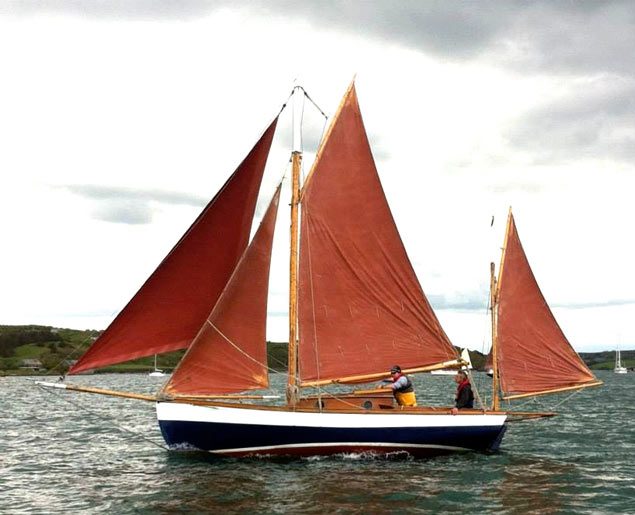 The pet boat. Jeremy Irons’ own sailing pride-and-joy in West Cork is the Willing Lass. As to her rig, the talk might go on all night as to whether she’s a ketch or a yawl.
The pet boat. Jeremy Irons’ own sailing pride-and-joy in West Cork is the Willing Lass. As to her rig, the talk might go on all night as to whether she’s a ketch or a yawl.
For those unfamiliar with the area, we hasten to say that the bay is named for the Roaringwater River which flows into it – Kilcoe Castle stands above reasonably serene waters, in the heart of an island-studded area where bustling Baltimore is within easy reach.
It was certainly beginning to bustle when the Ilen Boat-Building School of Limerick’s caravanserai – for no other word more aptly fills the bill – finally arrived in Baltimore with their eclectic collection of boats in tow or on trucks. And it was good to see that, as the larger fleet took up their berths at the harbour, there beside the quay was the familiar friendly shape of Jeremy Irons’ own little classic yawl, Willing Lass.
While the Ilen people had brought their usual range of Shannon gandelows and other craft, their little fleet in Baltimore included three dinghies of the Valentine Punt type, which originates from a 10ft punt built in 1926 at Passage West on Cork Harbour as a tender for John Valentine Sisk. His grandson Hal Sisk remembered so vividly the little boat’s wellnigh-perfect rowing ability, and her stability with remarkable load-carrying power, that he has made kits available to re-create the Valentine Punt in a much lighter Epoxy-built edge-glued version, which retains the use of clinker marine ply planks, but doesn’t require frames.
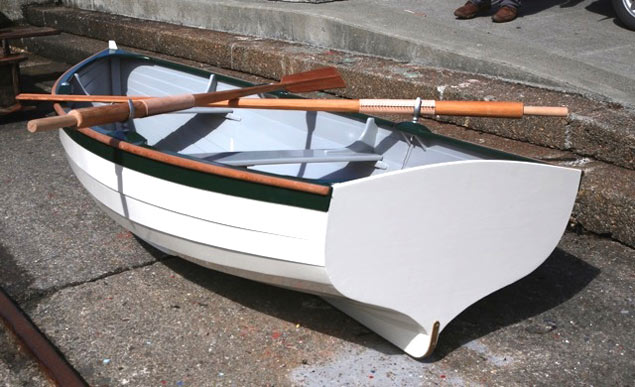 In honour of trainee boatbuilder Elan Broadley’s home county, the final touch of perfection for the new punt has been a Donegal green sheerstrake. Photo: Gary MacMahon
In honour of trainee boatbuilder Elan Broadley’s home county, the final touch of perfection for the new punt has been a Donegal green sheerstrake. Photo: Gary MacMahon
The Ilen Boat-Building School is always on the lookout for interesting new projects, so he donated one of the kits to its Limerick premises, and the job of building the boat was under-taken as a solo project by Elan Broadley from Donegal, with the school’s teacher Matt Dirr revealing his talents as a light-handed instructor.
For the young Donegal man, it was a lengthy and sometimes difficult process. But when the resulting 10ft punt was brought to the slip in Baltimore as the weather improved to a briskly sunny day on Saturday, it all became thoroughly worthwhile. The little boat simply looked a treat, the final perfection being a sheerstrake of Donegal green in honour of the builder.
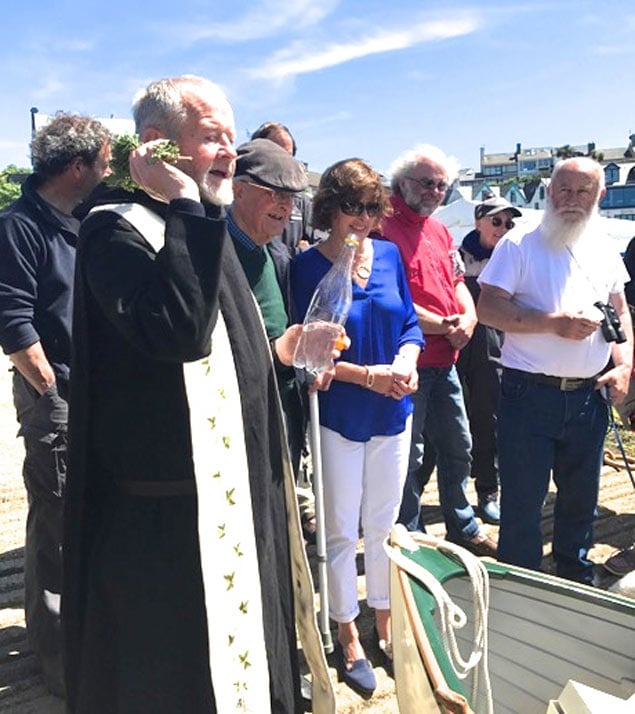 Brother Anthony of Glenstal Abbey blesses the new boat, assisted by Richard Bushe. Photo: Gary MacMahon
Brother Anthony of Glenstal Abbey blesses the new boat, assisted by Richard Bushe. Photo: Gary MacMahon
Elan’s mother Geraldine had come down from Donegal for this very special occasion, while Hal Sisk had come from Dun Laoghaire and leading traditional boat enthusiasts such as Paddy Barry had also travelled to be there with folk like Mary Jordan who keep the Baltimore Woodenboat show on the road, and it became one of those informal gatherings which somehow acquires its own momentum.
The boat was blessed by Brother Anthony Keane from Glenstal Abbey, who is a Director of the Ilen Boat-Building School, assisted by Richard Bushe on behalf of the Baltimore maritime community. A very special cake, dedicated to Hal and Matt, was ceremoniously sliced and consumed with enthusiasm, and then after the two other Valentine Punts had been sent off to row about in the inner harbour as a welcoming escort, the new boat took to the water for the first time.
 A very special cake gave thanks from Elan Broadley to Hal Sisk, the donor of the boat-building kit, and Matt Dirr the Ilen School Instructor. Photo: Gary MacMahon
A very special cake gave thanks from Elan Broadley to Hal Sisk, the donor of the boat-building kit, and Matt Dirr the Ilen School Instructor. Photo: Gary MacMahon
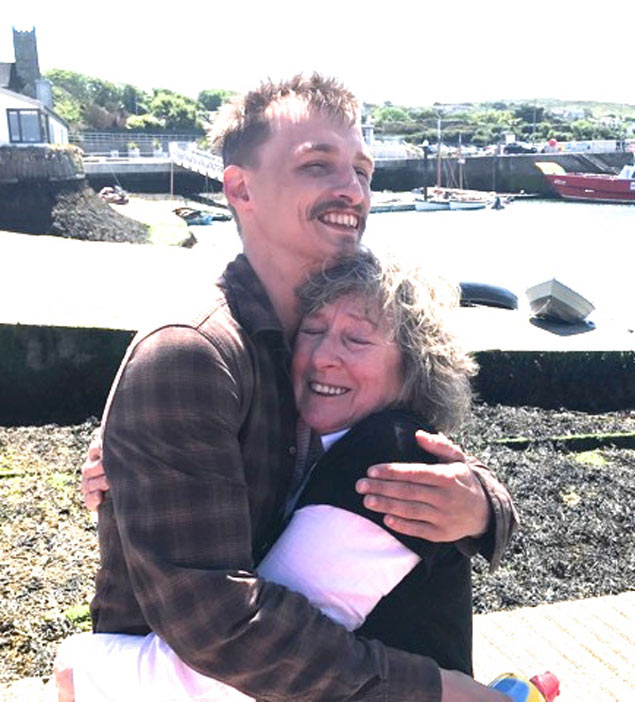 “Well done!” Mary Jordan of the Baltimore Woodenboat & Seafood Festival gives her warmest approval to Elan Broadley for his efforts. Photo: Gary MacMahon
“Well done!” Mary Jordan of the Baltimore Woodenboat & Seafood Festival gives her warmest approval to Elan Broadley for his efforts. Photo: Gary MacMahon
It was now that Hal Sisk reckoned he’d the perfect opportunity to demonstrate the Valentine Punt’s excellent load-carrying capacity, and somehow Jeremy Irons – who has long taken a close interest in the Ilen project – was roped in to help people aboard and send a worthwhile payload afloat. Like the good trouper he is, he threw himself into the role with relish, and the new dinghy – with Hal himself doing the rowing from the useful bow position – showed she could confidently carry six people, including the young boat-builder’s mother.
 Always a willing trouper – Jeremy Irons enthusiastically took on he role of quayside attendant and boat loader
Always a willing trouper – Jeremy Irons enthusiastically took on he role of quayside attendant and boat loader
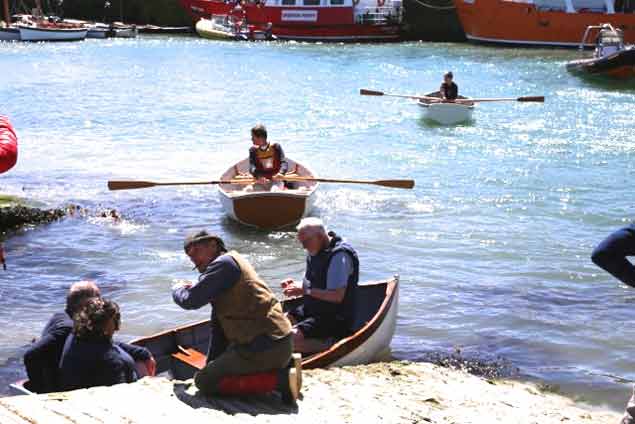 “Come on, there’s plenty of room for lots more......” Jeremy Irons piling them in, while the two sister-punts row out into the harbour. Photo: Gary MacMahon
“Come on, there’s plenty of room for lots more......” Jeremy Irons piling them in, while the two sister-punts row out into the harbour. Photo: Gary MacMahon
It’s not every day that you can travel all the way from Donegal to West Cork to see the first boat built by your son being launched in front of such an extraordinary and approving group. And then to be helped on board that same boat by a real international superstar successfully pretending to be a quayside attendant....well, it made Geraldine’s day.
In fact, it made everyone’s day. In this one charming little launching ceremony, the message of hope which is embodied in the Ilen Boat-Building School became clear for all to see, share and understand.
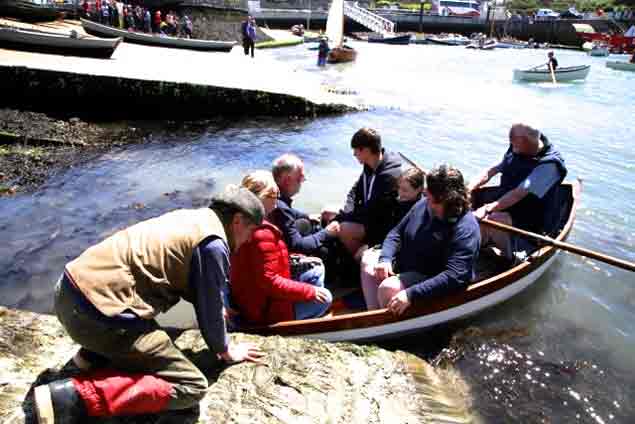 Sending them on their way – with Hal Sisk on the oars, the little punt takes the load. Photo: Gary McMahon
Sending them on their way – with Hal Sisk on the oars, the little punt takes the load. Photo: Gary McMahon
 Job done. Elan’s mother Geraldine (red jacket) floats for the first time in the punt her son built. In the interests of safety, they stayed strictly in the shallowest water, but the little punt carried the load very well. Photo: Gary MacMahon
Job done. Elan’s mother Geraldine (red jacket) floats for the first time in the punt her son built. In the interests of safety, they stayed strictly in the shallowest water, but the little punt carried the load very well. Photo: Gary MacMahon
The annual Baltimore Wooden boat Festival this weekend (full dates are Friday 26th to Sunday 28th May) provides the perfect setting for a remarkable range of craft of all shapes, sizes and rigs writes W M Nixon. It brings with it all sorts of celebrations and activities afloat and ashore to match an occasionally – indeed, frequently – eccentric gathering of traditional and wooden boat fans.
Scroll down this story to read the full programme below.
In fact, there’s noting quite like it on sea or land anywhere in Ireland, as it’s a heady mixture of craft of types sometimes half as ancient as time itself, testing themselves afloat and against each other, with all of it including the inter-boat banter which is so much part of the sport.
Best of all, the meteorological portents are good - it looks as though it is going to happen in what might well be a weekend of better than reasonably good summer weather, so we can expect the hospitable sea-minded West Cork port to be totally en fete afloat and ashore.
They’ll be coming from all over Ireland and beyond, and a significant presence will be the Ilen Boat Building School from Limerick. Not only is their 57ft ketch Ilen nearing restoration near Baltimore at Oldcourt, but they will be bringing a collection of craft built by trainees in the school, where they also built the deckhouses and spars for the Ilen.
A focus of close attention will be one of the smallest boats of all, the 10ft Valentine Punt, which is assembled from a laser-cut kit based on marine plywood. The basic design used is a 10ft dinghy built in the 1920s in Passage West on Cork Harbour for John Valentine Sisk, and it his grandson, maritime historian Hal Sisk, who vividly remembers what a special pleasure it was to row this elegant yet practical little boat.
 The new Valentine Punt built by Elan Broadley in the Ilen Boatbuilding School in Limerick is remarkable for its lightness. Photo Gary MacMahon
The new Valentine Punt built by Elan Broadley in the Ilen Boatbuilding School in Limerick is remarkable for its lightness. Photo Gary MacMahon
Thus he got the idea of making building kits available, using edge-glued (with epoxy) plywood “planks” to emulate the original’s traditional clinker construction, thereby providing a boat which is lighter yet more durable with much less maintenance.
When Hal heard the Ilen people were looking for a dinghy to act as tender for their vessel, he donated one of the kits to the school. And this newest Valentine Punt, which will debut in Baltimore at the weekend, has been built in the Limerick school by Elan Broadley from Donegal.
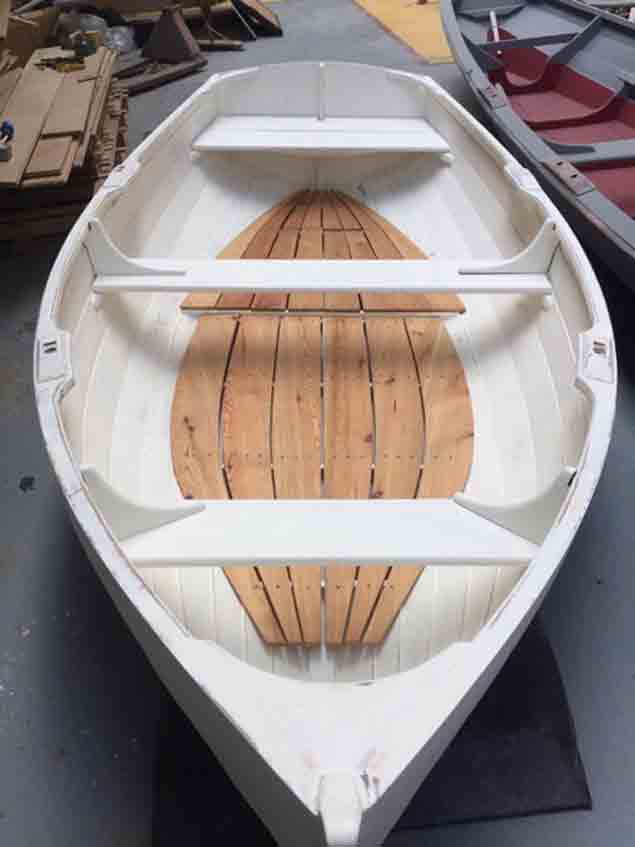 With edge-glued “clinker” construction, the new Valentine Punt is easily maintained – unlike a traditional clinker boat as the bilges can be cleaned in seconds. Photo: Gary MacMahon
With edge-glued “clinker” construction, the new Valentine Punt is easily maintained – unlike a traditional clinker boat as the bilges can be cleaned in seconds. Photo: Gary MacMahon
He had no experience of boatbuilding when he started, yet with patience he has learned as he worked, under instruction when needed. It may have taken 500 hours in all for him to complete the job, but the result is a lovely little boat. Among those there to celebrate with her proud builder at Baltimore this weekend will be his mother down from Donegal, and Hal Sisk, who learned to row in the original boat more than sixty years ago.
So in Baltimore this weekend, the mood in the sunshine will be of nostalgia and anticipation. Soon, the Ilen will launch. And once she is in full commission, the focus will turn to building a re-creation of Conor O’Brien’s famous world-girdling 40ft ketch Saoirse, originally built in Baltimore 95 years ago. Her re-birth comfortably in advance of her Centenary in 2022 is a very worthy target.
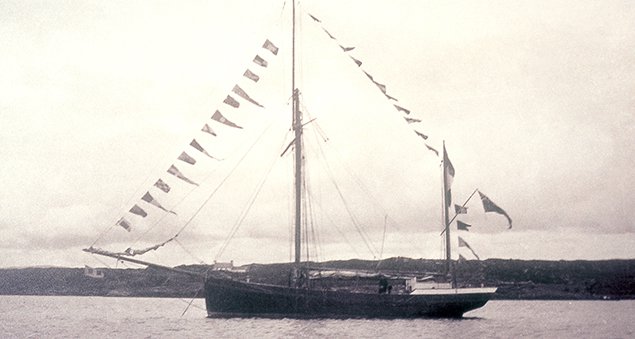 Ilen on her first commissioning day at Baltimore in 1927
Ilen on her first commissioning day at Baltimore in 1927
The Baltimore Wooden Boat Festival 2017 from Friday 26th to Sunday 28th May will feature a remarkable selection of old, restored and new craft - traditional and classic alike - all reflecting the many aspects of the arts and crafts of the boatwright and shipwright writes W M Nixon.
The hospitable setting is highly appropriate, as there are more skilled boatbuilders beavering away in hidden workshops in West Cork than in any other comparable part of Ireland. And a few miles upriver from Baltimore on the River Ilen (which in due course brings you to the Olympic Medal-winning Skibbereen Rowing Club), you’ll find the boatyards of Oldcourt, where among other projects, Liam Hegarty and his craftsmen are bringing the restoration of the 1927-built ketch Ilen of Conor O’Brien fame to completion.
It’s the Ilen which provides a link to a notable debut at Baltimore by a new small boat in three weeks’ time. With both his world-girdling 40ft Saoirse of 1923, and the 57ft trading ketch Ilen which he delivered to her satisfied customers in the Falkland Islands, O’Brien felt that a robust and stable 10ft dinghy – or punt as he would have called it – provided all that he needed in the way of a ship’s tender.
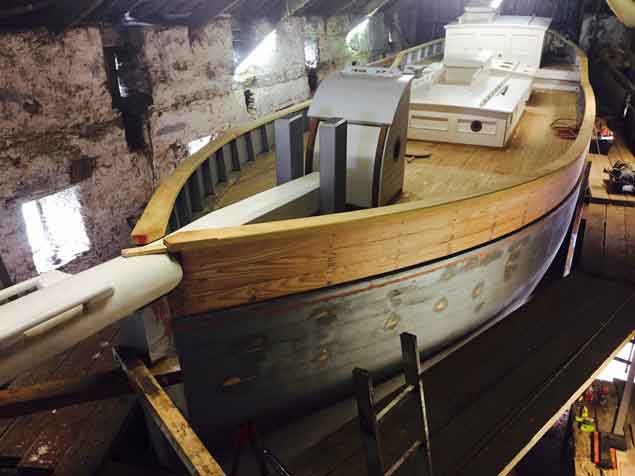 Progress continues on the restoration of Ilen. All the deckhouses - built in the Ilen Boatbuilding School in Limerick – have now been installed in the ship herself at Oldcourt near Baltimore. Photo Gary MacMahon
Progress continues on the restoration of Ilen. All the deckhouses - built in the Ilen Boatbuilding School in Limerick – have now been installed in the ship herself at Oldcourt near Baltimore. Photo Gary MacMahon
He wasn’t alone in this view. At the same time in 1926 on Cork Harbour, John Valentine Sisk, owner of the substantial motor-launch Culleann, ordered a new 10ft punt for use as Culleann’s tender from noted Passage West boatbuilder Pierce Power. Cullean already had a 10ft punt, but it was considered too unstable. So Pierce Power faced the considerable challenge of creating a boat only 10ft long with firm midships sections for stability, yet with bow and stern artfully shaped to retain her predecessor’s ease of rowing.
He succeeded brilliantly, so much so that the Sisk family kept the punt after Cullean had moved on. Before John Valentine Sisk’s death in 1957, his three grandsons George, Hal and John had learned to row in this very special little boat. Then with his son John G Sisk now moved to Dublin, the Valentine Punt followed to be the tender to his Dun Laoghaire-based yachts Marian Maid, Stern and Sarnia until 1970.
She then went to a son-in-law Schull, and eventually was bought by fishermen on Long Island, where her yacht-style varnish was painted over, and finally tarred. She was reckoned past her working days when Hal Sisk found this fondly-remembered boat of his childhood and youth on the island, and had her restored. In time, she became part of the collection in the National Maritime Museum in Dun Laoghaire as representative of a type once found at every yacht and fishing harbour on Ireland’s south coast, and many other ports and anchorages elsewhere.
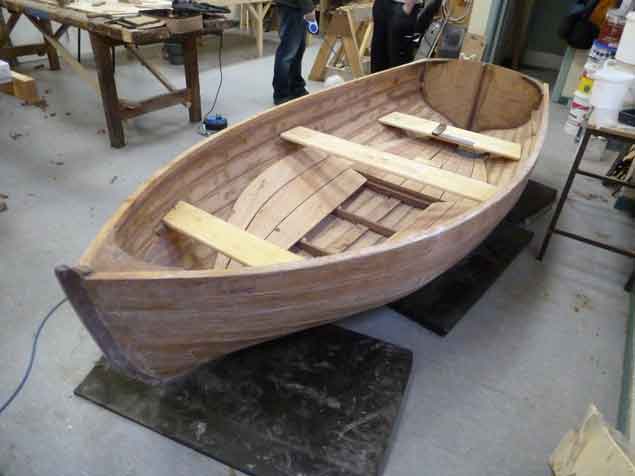 The Valentine Punt with the aft thwart removed to show the carefully-calculated shape of the transom – when afloat, it will offer minimum drag while helping when necessary with the hull form’s inherent stability.
The Valentine Punt with the aft thwart removed to show the carefully-calculated shape of the transom – when afloat, it will offer minimum drag while helping when necessary with the hull form’s inherent stability.
However, it was the ease of rowing the Valentine Punt which was the fondest memory, so the late Michael Tyrrell of Arklow took off her lines for Hal Sisk with a re-creation in mind. But it was reckoned that real benefit would be conferred if the lines could be used, yet instead of the inevitably heavy traditional clinker construction with ribs (timbers), much lighter construction could be achieved by building instead with glued clinker ply.
Alec Jordan in Scotland is an acknowledged expert in creating laser cut marine ply kits, which are then built into a boat with the “lands” of the lapstrake planks now bonded and sealed with impervious gap-filling epoxy resin. The result of this project was an elegant hyper-light and easily-rowed yet stable 10ft punt which has been the ideal tender for Hal Sisk’s classic cutter Peggy Bawn and his innovative motor-cruiser Molly Bawn.
The Valentine Punt is a concept which could have many uses, and when the notion of having one as the tender to the restored Ilen came up, the Ilen Boatbuilding School director Gary MacMahon in Limerick leapt at the chance, as the school is always enthusiastic about testing new methods of wooden boatbuilding to broaden its syllabus.
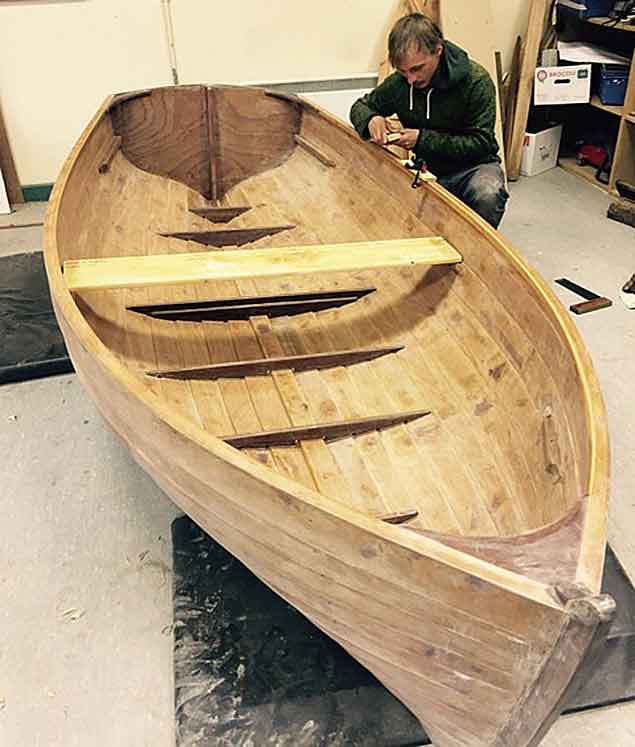 Elan Broadley at work on his special creation, the latest Valentine punt developed from a proven design which is now 91 years old. Photo: Gary MacMahon
Elan Broadley at work on his special creation, the latest Valentine punt developed from a proven design which is now 91 years old. Photo: Gary MacMahon
This latest model of the Valentine Punt has been built in the school by Elan Broadley, a trainee boatbuilder from Donegal, and he and his attractive creation will be making their debut in Baltimore during the Wooden Boat Festival, with a bit of a party involving all the main players, and his mum down from Donegal. After that, the little boat won’t have far to go to be united with her mother ship, the Ilen herself, preparing for launching at Oldcourt.
Christmas Dreams Of Irish Wooden Boats – Old & New, Real & Fantasy
The season is upon us for goodwill and dreams of very special gifts. And for many Irish sailors, the dream Christmas present would be an elegantly classic or solidly traditional wooden boat, with all maintenance and running costs somehow covered by Divine Providence into infinity……W M Nixon goes down the Yuletide timber trail.
Love of wood is part of what we are. It’s in our genes. At some times and some places in the remote past, an instinctive fondness for wood, and an inherited ability to do something useful with it, would make all the difference between survival and extinction. So though today the availability of other more purposeful materials may have transformed boat-building, a new boat without some sort of wood trim is a very rare thing indeed.
At a more personal level, many of today’s generation of sailors cherish family memories of the communal building of wooden DIY kit boats at home. Here, there and everywhere, a drawing room or little-used dining room found itself a useful new purpose as a boat-building salon, with Mirror dinghies and occasionally larger craft taking shape in domestic settings throughout the land.
“Our daddy the boat-builder” became a household name in his own household. And for those who sometimes wonder why today’s adult sailors can become misty-eyed at the very thought of the Mirror dinghy (which really was and is a wonderful design and concept), the answer surely is that at a significant stage of their sailing and family life, a Mirror dinghy was centre stage, the symbol of a family’s shared values, hopes and interests.
But maybe the most important thing about the Mirror is that she is so eminently practical. So perhaps at Christmas we should allow our imaginations to take flight and soar high to envisage the complete wooden dreamship. And there she is as our header image, introducing this week’s meandering thoughts. That schooner at the moment is total fantasy. But any sailing enthusiast who looks at that concept design and doesn’t think: “Now there’s my dreamship”, well, he or she just doesn’t have a true sailing soul.
The origins of Eirinn, as she is named for the time being, go back to 2012, when the nascent Atlantic Youth Trust sought suggestions as to what a new sail training vessel for all Ireland should look like. But with their proposals recently getting the first real hints of a fair wind from both governments, the AYT have gone firmly down the route of a 40 metre steel barquentine.

The Ilen as she was in the Spring of 2015 in Oldcourt...
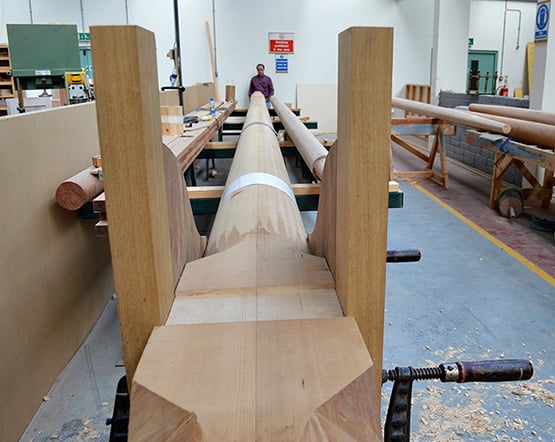 ….while in the Ilen Boatbuilding School in Limerick, spars and deckhouses were taking shape
….while in the Ilen Boatbuilding School in Limerick, spars and deckhouses were taking shape
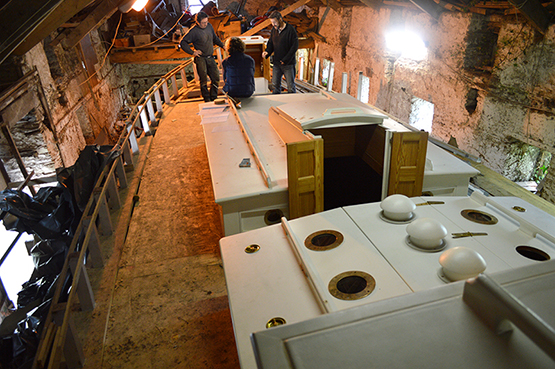
Deckhouses built in Limerick are offered up on the Ilen in Oldcourt
However, down in Limerick where they were busy with moving forward the restoration of the Conor O’Brien 1926 ketch Ilen at two sites – the hull with Liam Hegarty in Oldcourt near Baltimore in West Cork, and the deckhouses, spars and other smaller items being built at the Ilen Boat Building School in Limerick – they gave some thought in 2012 to the possible form of a new sail training vessel. They came up with the concept of a classic 70ft schooner which they knew, thanks to the work on Ilen, that they could build themselves using the skills learned and deployed in re-building the O’Brien ketch.
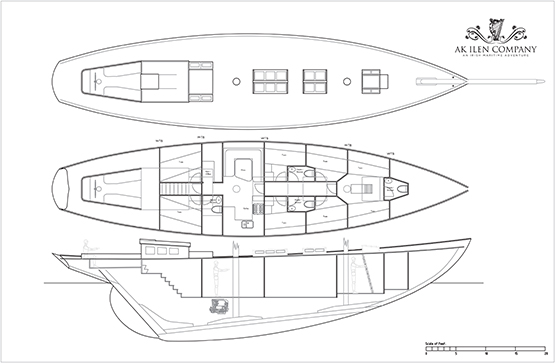
A classic hull for a classic schooner – Theo Rye’s profile and general arrangements plan for the schooner concept of 2012
But with the Ilen project moving steadily on towards the vessel’s commissioning next summer, and with other directly-related new proposals at an advanced stage in the pipeline, that sublime schooner concept is in a sort of limbo, truly a fantasy.
Yet she’s such a lovely thing that we’re happy to use her as our symbol of Christmas cheer. Her creators are Gary MacMahon of the Ilen Boatbuilding School, and Theo Rye, who is best known as a technical consultant in naval architecture, and on clarifying matters of design history and detail in boat and yacht design. But he can turn his hand to all sorts of design commissions if required. He came up with the clever concept for the CityOne dinghies in Limerick, and when Gary started musing about a classic training schooner, within the scope of what the Ilen school could do, as their answer to the AYT sail training vessel query, Theo came up with the goods and then some.
In fact, the design of the hull is so perfect that we’ll run it again right here to save you the trouble of scrolling back to the top. The overhangs at bow and stern are in harmony, but it is the sheerline which is the master-stroke. There isn’t anything you’d want to change in it, yet when you look at other famous schooners such as the fictional Southseaman (in real life she was Northern Light) in Weston Martyr’s masterpiece of maritime literature The Southseaman – the Story of a Schooner (1926), we see a sheerline which is too flat in the way of the foremast. But with Eirinn, the curve is just right, and it’s something achieved by tiny adjustments and balances which the eye can’t really perceive, yet somehow it registers the sublime harmony of the total concept.
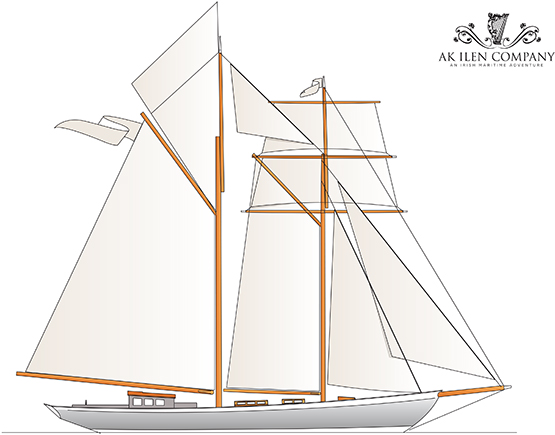
Worth a second look – and then a third one. The longer you look at the lines of Eirinn, the sweeter they seem. But her overall appearance might be improved with a slight rake of the masts
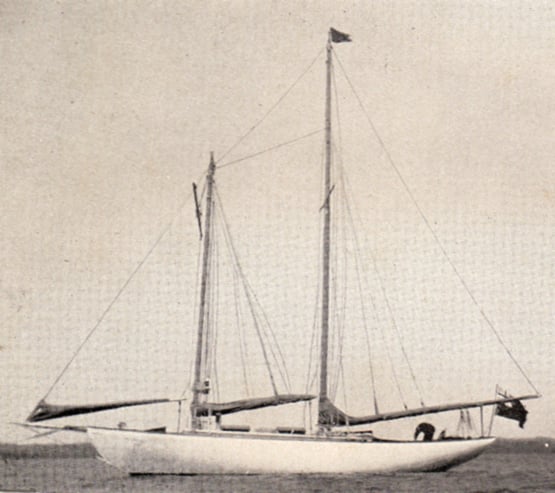 A schooner sheer not quite right – Weston Martyr’s Southseaman (aka Northern Light) could have done with a livelier sheerline abeam of the foremast.
A schooner sheer not quite right – Weston Martyr’s Southseaman (aka Northern Light) could have done with a livelier sheerline abeam of the foremast.
So Theo Rye not only writes critiques of other people’s designs, but if given the chance he can personally come up with something which is wellnigh impossible to fault. Of course, we mightn’t quite go for the same rig – a little bit of rake in the masts wouldn’t go amiss - and for private use you’d want something a little different from the dormitory layout of the training ship. But that said, this is a beautiful yet not excessively pretty-pretty hull, a boat which sings. And the fact that she’s beyond just about every private owner’s reach only adds to the mystique.
But to redress the balance, last week we’d an inspiring evening’s entertainment and information about a dreamship which really is being re-created. It was the December gathering of the Dublin Bay Old Gaffers Association in the ever-hospitable Poolbeg Y & BC, and a full house was there to hear about how Paddy Murphy of Renvyle in the far northwest of Connemara is getting on with his mission of bringing the famous Manx sailing nobby Aigh Vie back to life.
Paddy himself is something special. When asked his trade, he says he’s a blacksmith. But he can turn his hand to anything. Originally a Dub, his early sailing experiences included owning a Flying Fifteen and a Dragon, though not – so far as I know – at the same time. But then got the gaff rig traditional boat bug, and a sail on Mick Hunt’s Manx nobby Vervine Blossom sent him in pursuit of near-sister Aigh Vie. She was reportedly for sale, having for a long time been the pet family cruising boat of Billy Smyth and his family at Whiterock Boatyard on Strangford Lough, after spending her final working years fishing as a motorized vessel out of Ardglass.

Aigh Vie as she was in Whiterock Boatyard when Paddy Murphy bought her, her elegant huul shape clearly in evidence
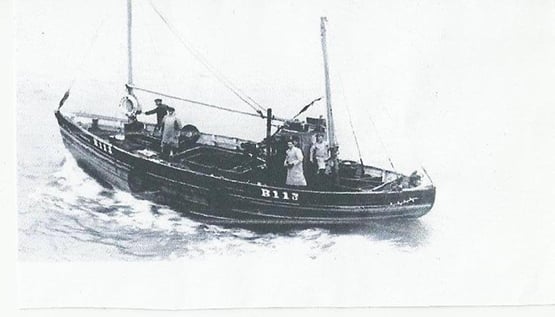 Aigh Vie in her final working days as a motorised fishing boat based at Ardglass
Aigh Vie in her final working days as a motorised fishing boat based at Ardglass
The deal was done, an ideal buy for a special man like Paddy Murphy, for the Aigh Vie is one very special vessel. The Manx fishing nobbies reached their ultimate state of development in the first twenty years of the 20th Century before steam power and then diesel engines took over. The nobby evolved to an almost yacht-like form through vessels like the 43ft White Heather (1904), which is owned and sailed under original-style dipping lug rig by Mike Clark in the Isle of Man, and the 1910 Vervine Blossom, now based in Kinvara, which was restored by Mick Hunt of Howth, but he gave her a more easily-handled gaff ketch rig which looked very well indeed when she sailed in the Vigo to Dublin Tall Ships Race in 1998.
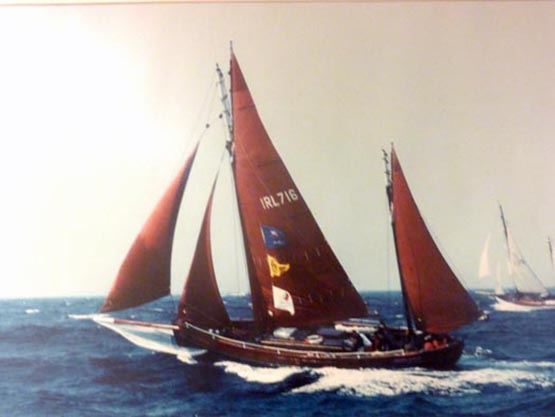
It was a sail on Mick Hunt’s 1910-built Manx nobby Vervine Blossom which inspired Paddy Murphy to go in pursuit of Aigh Vie
It takes quite something to outdo the provenance of these two fine vessels, but the story of Aigh Vie (it means a sort of mix of “good luck” and “fair winds” in Manx) is astonishing. It goes back to the sinking of the Lusitania by a German U Boat off the Cork coast in May 1915, when the first boat to mount a rescue was the Manx fishing ketch Wanderer from Peel, her crew of seven skippered by the 58-year-old William Ball.
They came upon a scene of developing carnage. Yet somehow, the little Wanderer managed to haul aboard and find space for 160 survivors, and provide them with succour and shelter as they made for port. In due course, as the enormity of the incident became clear, the achievement of the Wanderer’s crew was to be recognised with a special medal presentation. And then William Ball, who had been an employee of the Wanderer’s owner, received word that funds had been lodged with a lawyer in Peel on behalf of one of the American survivors he’d rescued. The money was to be used to underwrite the building of his own fishing boat, to be built in Peel to his personal specifications. The name of the donor has never been revealed, but the result was William Ball’s dreamship, the Aigh Vie, launched in December 1916 and first registered for fishing in January 1917.
Over the years, the Aigh Vie became a much-loved feature of the Irish Sea fishing fleet. Tim Magennis, former President of the Dublin Bay Old Gaffers Association, well remembers her from his boyhood days in the fishing port of Ardglass on the County Down coast. Her working days over, Billy Smyth gradually converted her to a Bermudan-rigged cruising ketch with a sheltering wheelhouse which enabled the Smyth family to make some notable cruises whatever the weather. His son Kenny Smyth, who now runs the boatyard with his brothers and is himself an ace helm in the local 29ft River Class, recalls that the seafaring Smyth family thought nothing of taking the Aigh Vie to the Orkneys at a time when the average Strangford Lough cruiser thought Tobermory the limit of reasonable ambitions.
After he’d bought the Aigh Vie and brought to her first base in Howth, Paddy Murphy soon realised he’d still a lot to learn about sailing and about keeping hard-worked old wooden boats in seafaring condition. But he’s such an entertaining and inspirational speaker that you’re swept along in his enthusiasm and empathise with his admission that, now and again, he felt things were getting on top of him.
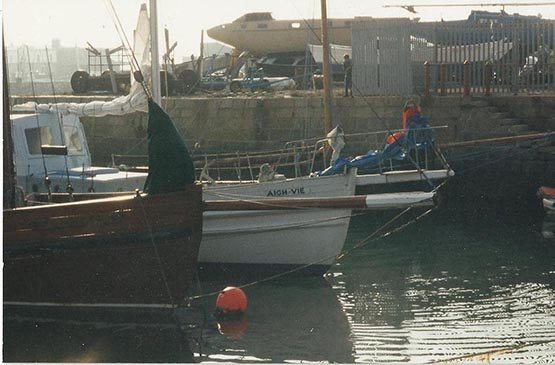
Sisters - Vervine Blossom (foreground) and Aigh Vie in Howth
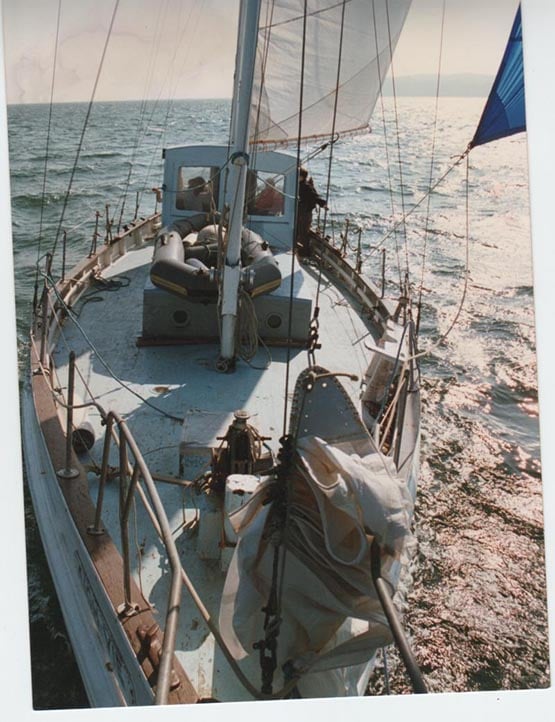
Sailing days on the Aigh Vie from Howth, before it was decided that she needed a major restoration
Following several seasons with increasing evidence of problems, he decided that a virtual re-build was necessary. It was then that the Dublin wooden boat owners’ perennial problem shot to the top of the agenda. In our very expensive city, the space and shelter to work long hours at an old wooden boats is almost impossible to come by, and he’d to shift the big Aigh Vie several times. On one occasion, he was asked to move in a hurry out of an ESB shed, but was offered £1,000 (this was pre-Euro days) to do so. He moved heaven and earth and finally found somewhere else at considerable expense, got the Aigh Vie installed there, and then went back to collect his thousand snots. Only to be laughed at. The manager told him it was the only way he could see to get the old boat moved out, but there were absolutely no funds available at all for such a thing, and surely Paddy would have guessed that?
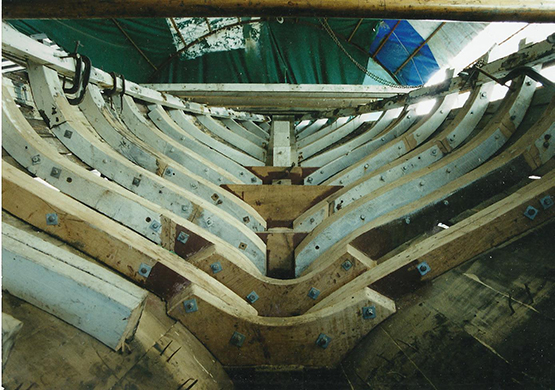
The re-building under way at Renvyle, using the technique where hull shape is retained by first replacing every other frame
With one thing and another, he moved to Renvyle in Connemara where he liked the big country and the open spaces and the friendly people right on the edge of the Atlantic, and in time Aigh Vie came too, and found herself being slowly re-born under a special roof. But it was demanding work for one man, so every so often a team led by Paul Keogh of the famous Galway Hooker from Clondalkin, the Naomh Cronan, together with a good selection of DBOGA specialist talent, descends on Renvyle to put in a ferocious day or two of work, and then on the Saturday night they put a fair bit of business the way of the pub at Tullycross.
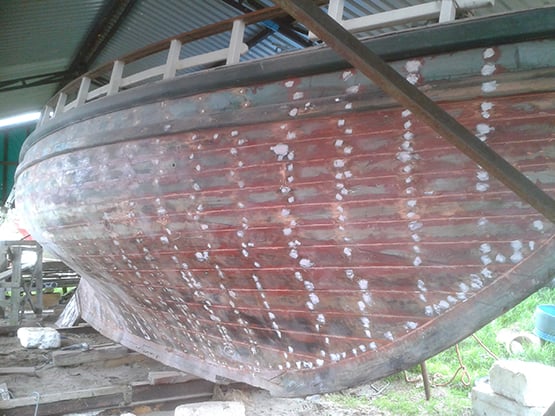
The planking was more easily restored by laying the Aigh Vie over on her side
Agh Vie upright again, and the deckhouses are being put in place
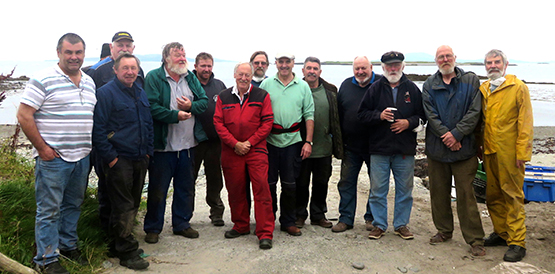
Old Gaffers Association International President Sean Walsh (right) and Peter Redmond install Aigh Vie’s new Perkins diesel. Photo: Cormac Lowth

One of the options for Aig Vie’s rig is the classic lug ketch as shown here with Mike Clark’s 1903-built White Heather
So now, many years later, the journey towards the restored Aigh Vie is getting near its destination. But it will never be fully ended. Thanks to sails, spars and rigs donated from other boats, Paddy has the choice of either gaff ketch or classic lug rig, so she’ll always be work in progress. Which is good news. Because every couple of years or so, the DBOGA can guarantee a full house to hear Paddy Murphy talking about how the Aigh Vie story is going.
He’s a wonderful speaker, sometimes almost messianic, and he shares his every feeling. Thus he mentioned that one day he was feeling a bit low, and he just went out to look at the big boat down by the shore, seeking some sort of inspiration. His mind had been elsewhere with the details of completing the interior, but he suddenly realised that he was at the stage of thinking of putting the white paint on the topsides. So he just set to with a big paint brush and a bigger tin of paint, and Aigh Vie was transformed. So was he. “That’s the secret” says he. “If you’re feeling a bit down, just go out and slap on some white paint. It works wonders.”

Feeling a bit down? Then just go out and slap a coat of white paint on the boat – it works wonders
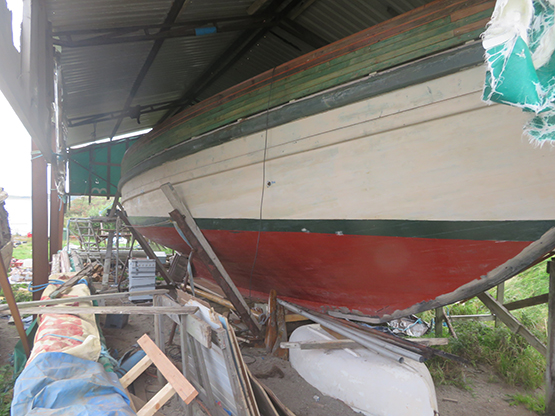
#baltimorewoodenboatfestival – The Ilen School Gandelow crew are celebrating back in Limerick after taking the big rowing prizes at the Baltimore Wooden Boat Festival last weekend.
Rowing races at the West Cork festival included on Sunday a Pilot Race Event under sail and oar; a race to land a pilot on an incoming sailing boat in the Harbour then race back to finish at the Pier.
The crew were: Br Anthony Keane, Gary Wilmott, Matt Dirr, Ger Ryan, Tony Daly, Robert Smalle, Liam O'Donoghue, Mike Grimes and James Madigan.
More on the wooden boat festival
#woodenboats – In the annals of Irish seafaring, whether professional or amateur, only a very few can match the achievement of Conor O'Brien (1880-1952). Between 1923 and 1925, this multi-talented sailor from Foynes on the Shannon Estuary circled the world south of the Great Capes in the 42ft ketch Saoirse which he'd designed himself with the help of Tom Moynihan of the Baltimore Fisheries School Boatyard.
It was there that this unique vessel was built in 1922-23 as Ireland in general – and West Cork in particular – recovered from a short but brutal Civil War. The very fact that Saoirse was built in Baltimore, followed by the successful completion of her great voyage, became part of the slow post-war healing process. So as the 2015 Traditional and Classic Boat Season gets under way this weekend with the Baltimore Wooden Boat Festival, W M Nixon voices the hope that Saoirse – which had been feared totally lost since 1979 – may be re-born.
They're hardy sailors in West Cork. That lotus-land of easygoing cruising may seem a gentle place in high summer, yet down there they've felt the recent summer-delaying cold spell as sharply as anywhere else. But despite the unfavourable conditions, as usual in this last full weekend of May we'll see the Baltimore Woodenboat & Seafood Festival swing into action. And although wooden boats need reasonably good springtime weather almost as an essential for the annual refit, there'll be a colourful turnout of character vessels large and small.
But the talk of the town will not be about a boat which is showing her style off the busy Baltimore waterfront today. Indeed, not only will this very special boat not be there, but it's a moot point as to whether she still exists. Put another way: Does enough of Saoirse still exists to allow a re-creation of this wonderful little ship to be properly classified as a re-build?
The voyage of the Saoirse in 1923-1925 only gains further lustre and wonder with the passage of time. It was an achievement of greatness, yet of beautiful simplicity. It was a uniquely pioneering venture made by an Irish skipper in an Irish designed-and-built vessel, and it was the first major voyage by an Irish ship of any size flying the Tricolour ensign of the new-born nation.
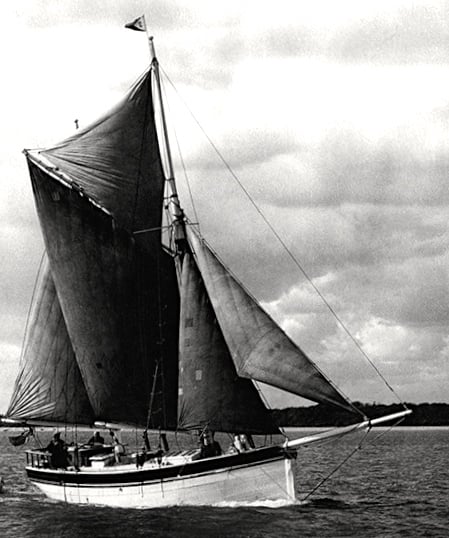
Saoirse under her original ketch rig in the 1950s, but with a boom fitted to the mainsail. Conor O'Brien had a loose-footed mainsail, and as evidenced here, the sail would have set much better but would have needed more attention in handling. (From a photo by Eric Hiscock)

In dry dock during the 1950s, Saoirse's "cod's head & mackerel tail" hull shape is clearly seen. Yet in the Great Southern Ocean on her voyage round the world south of the Great Capes, this bluff little 42ft ketch regularly logged 180 miles a day in comfort.
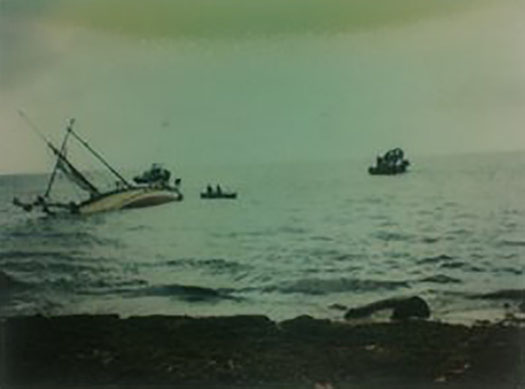
The wreck of the Saoirse in Jamaica, 1979.
Thus when the news in 1979 of Saoirse's destruction in a hurricane in Jamaica was confirmed, if anything it added to the legend. But it also meant that the only other boat created by the same team in the same place – the 56ft trading ketch Ilen (1926) – acquired added significance. But she was a long way away, still working the stormy seas around the Falkland Island, for which she'd been built after the islanders had been so impressed by the capabilities of the Saoirse, when she called there after rounding Cape Horn from the west, that they ordered a bigger sister-ship to become the inter-island workboat .
Yet thanks to a totally single-minded approach by Gary MacMahon of Limerick, Ilen was brought back to Ireland in 1998. And though it has taken quite a while for the various ideas to become reality, she is now well on the way to what has become a very public restoration with Liam Hegarty at Oldcourt Boatyard near Baltimore, while the Ilen Boatbuilding School in Limerick has become part of the fabric of Shannonside life, building not only the deckhouses and spars for Ilen herself, but an interesting selection of smaller boats ranging from traditional Shannon gandelows to the new CityOne sailing dinghies.

A man who just doesn't give up. Gary MacMahon of the Ilen School in Limerick. Photo: W M Nixon
By any standards, all these projects would be remarkable achievements in themselves. But in addition to his day job running one of Limerick's leading design studios, Gary MacMahon has for twenty years and more been quietly accumulating every bit of documentation of all sorts there is to be found relating to Saoirse.
It's an absolute treasure hoard of old photographs, certificates, plans, artefacts and other materials. And through this collecting, he has become well acquainted with Anthony Bolton who was Saoirse's last owner. Bolton had the misfortune of seeing his beloved boat destroyed by a hurricane in Jamaica before rescue attempts could save her after she'd dragged her anchor and gone ashore.
But though Saoirse was broken up by the battering of the hurricane, substantial pieces of her remained on the sea bed, and two sea-worn iron hanging knees – lovingly fitted by the Baltimore shipwrights 93 years ago – have recently been confirmed as definite relics of the wonderful little ship.
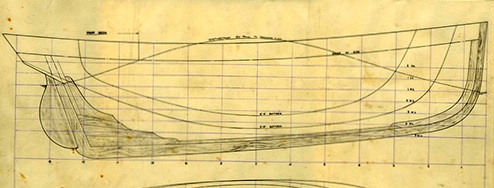
The hull lines of Saoirse as taken off by Uffa Fox in Cowes in 1927 before the start of that year's Fastnet Race (from which she retired, as endless windward work was not what she was designed for). Thanks to documentation of this quality, it will be possible to re-build Saoirse with precision. But in fact it has emerged that, such was the skill of Tom Moynihan and his boatbuilders in Baltimore in 1922-23, Saoirse as built very accurately followed the original lines drawn by O'Brien and Moynihan.

Saoirse's hull sections as recorded by Uffa Fox in 1927.
More importantly, though, the word is that much of the keel may still be intact. So just as he somehow got himself to the Falkland Islands to buy Ilen back in 1997, Gary MacMahon will shortly be going on the much easier journey to Jamaica for some real on-the-spot research as to just how much of Saoirse survives.
These days, it need only be a very small piece of the original to count as a re-build. But the spirit of the Ilen School is such that even if they find nothing at all in Jamaica, the notion of re-creating Saoirse is gaining so much traction, with that great shipwright Liam Hegarty among those totally taken with the idea of seeing Conor O'Brien's characterful little masterpiece sail again, that already the idea has acquired its own momentum.
But there'll be time enough when winter comes around again to give proper attention to the full range of Saoirse material which Gary MacMahon has amassed in order to ensure an authentic re-build. Meanwhile, this weekend may be seeing the new classic and traditional boat season kick into action in Baltimore, but already things are well under way in France, with last week's huge gathering in the Morbihan on the Biscay Coast, to which seven Dublin Bay Waterwags travelled, and eight returned.
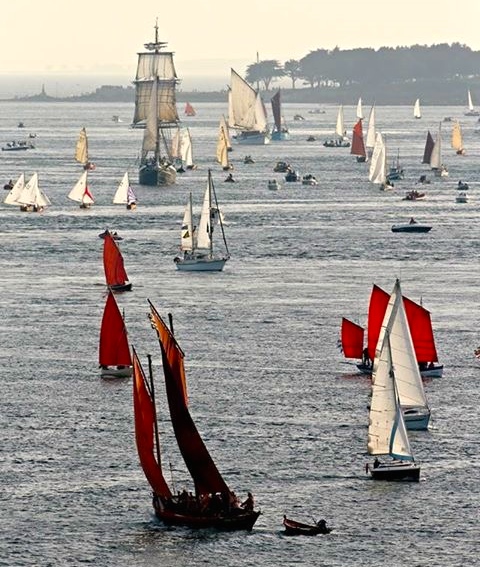
The wonders of the Morbihan. A very small part of the fleet at the Sailing Week eight days ago, with four of the Dublin Bay Water Wags at mid left. Photo: Courtesy Judith Malcolm
Like all the great French classic and tradboat festivals, the Morbihan event (it's full title is La Semaine de la Voile du Golfe de Morbihan, that's Morbihan Sailing Week in simple English) was mind-bending in terms of numbers, with 1200 boats of all shapes and sizes taking part. But the scale and layout of the Morbihan is such that it could well cope. The extensive inlet has six main ports, so the fleet was divided into six sub-groups of around 200 boats each. Everyone mingled out on the water during the day, then each night of the week-long festival saw your group going to a new port.
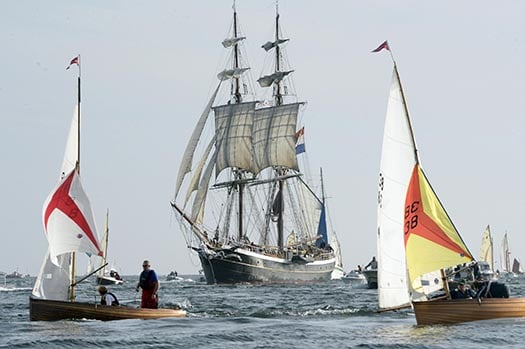
Two little Water Wags a long way from home – Ian & Judith Malcolm in the hundred year old Barbara (left) and Guy and Jackie Kilroy in Swift (right) in the midst of "sundry boats" in the Morbihan eight days ago. Photo courtesy Judith Malcolm
It worked, and it worked so well that the Irish flotilla of one Shannon One Design (Reggie Goodbody) and seven Water Wags not only had themselves a fine old time, but in a reversal of the usual story where our people return from distant places short of a boat or two, they came back with eight Wags, as Adam Winkelmann was united with his new boat. It was built in France as a boat-building academy exercise with a finish so exquisite that it was on exhibition in a marquee, but he was allowed to bring it home with him to Dublin Bay.
Far to the southwest in Baltimore, today we'll see a complex programme, as several traditional rowing craft (including a 23ft traditional Shannon cot or brochaun, the latest creation of Limerick's Ilen School built by a team headed by Tony Daly) were due to launch last night to berth at the pontoon in Skibbereen beside the West Cork Hotel. Today at 11am they start a rowing race all the way down the Ilen to Baltimore. Fortunately, the tide is ebbing.....
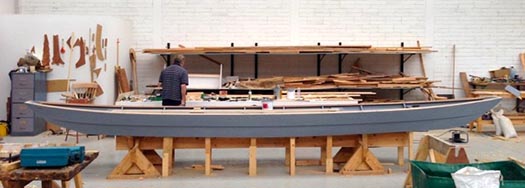
The new 23ft Shannon cot or brochaun is the latest creation of the Ilen School in Limerick. The cot's usual task was to head upriver from Limerick to fish, but today this boat will be rowed down the River Ilen from Sibbereen to the Baltimore Woodenboat Festival.
The rest of the day will see sailing and rowing races off Baltimore with a prize-giving dinner tonight in Baltimore Sailing Club presided over by Tom MacSweeney of this parish, then tomorrow (Sunday), as the one day Seafood Festival gets into full swing, there's perhaps the most interesting event of all afloat. This is the Pilot Race, in which the sailing boats put out to sea, and then turn and approach the harbour to be met by racing gigs each of which has to put a pilot on board one of the sailing craft which then race back into the harbour – it all makes for mighty sport.

Bowsprits at the ready, and the island ferry coming into port – it can only be Baltimore at Woodenboat Festival time
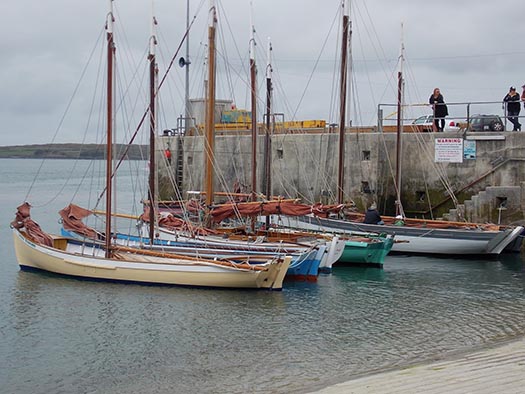
If you can identify even half of the boat types here, then you should be in Baltimore this weekend.
If your heart is with classic and traditional sailing boats, you can get an abundance of them by being in Baltimore this weekend, and then by being along Dublin's Liffey for the Riverfest in a week's time for the Bank Holiday weekend. It's a three day event (May 30th to June 1st) based on Poolbeg Y & BC, with the Old Gaffer's Leinster Trophy Race in Dublin Bay on Saturday, and then two days above the bridge for all sorts of city festivities and boat parades through to Monday evening.

The 117-year-old Howth 17s will be returning to the Dublin Riverfest in a week's time. Photo: W M Nixon
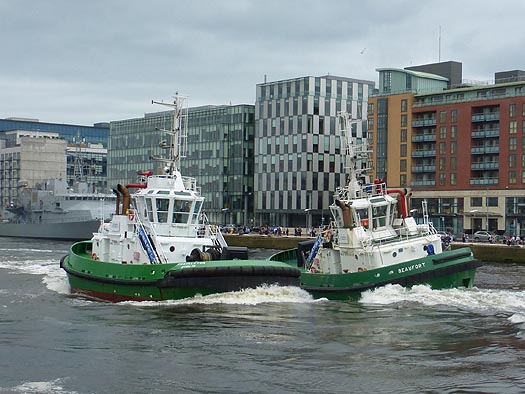
The famous waterborne ballet of the Dublin Port tugs Shackleton and Beaufort will be a main event in the Dublin Riverfest over the Bank Holiday Weekend of May 31st-June1st. Photo: W M Nixon
Following that, on Saturday 6th June out in Howth, the Classic Lambay Race is being provided within the annual Round Lambay Regatta (it dates back to 1904), with the Old Gaffers and Traditional boats joining the 117-year-old Howth Seventeens for a direct circuit from a pier start out to Lambay, round it and back again direct, with no fancy special mark rounding in between.
Defending champion in the Classic Lambay is OGA International President Sean Walsh of Dun Laoghaire with his cutter Tir na nOg, and extra interest is added this year as the fleet will include Dickie Gomes' 1912-vintage 36ft yawl Ainmara, built in Ringsend but now a longtime resident of Strangford Lough. There's a certain edge to Ainmara's involvement, as she was overall winner of the cruiser division in the 1921 Lambay Race when still owned and sailed by her designer-builder John B Kearney. But if you think this remarkable historic link will cause her opponents to give her an easy time of it, you're much mistaken.
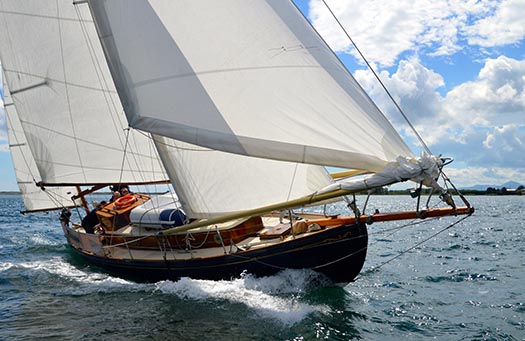
The 103-year old Ainmara – seen here on her home waters of Strangford Lough with the Mourne Mountains in the distance – will be returning to the Lambay Classic at Howth on June 6th 2015, which she last won in 1921. Photo: Pete Adams
Sean Walsh is having a busy year of it, as his duties as OGA President take him hither and yon, while Tir na nOg will be flagship for the OGA Cruise-in-Company which will follow the big one of 2015, the Glandore Classics Regatta from July 18th to 24th.
But for this weekend, he's in his home waters of Dublin Bay on a venture which means a lot to him, the OGA Youth Sailing Project at Poolbeg under the direction of Liam Begley. It's for youngsters who might not otherwise get a chance to sail. They're taken out to learn the ropes aboard two fine gaff cutters, the Clondalkin Community group's majestic Galway Bay hooker Naomh Cronan, and the OGA President's own Tir na nOg.
When we remember that many folk head from Dublin towards Cork to go sailing, it's intriguing that in this case the young people have come the other way, as they're a group from Mayfield Community School which has eternal fame through being the old school of Roy Keane.
The tyro sailors from Mayfield – there's nine of them, all in the 15-16 age group - have already become boat-acquainted through the Meitheal Mara Community Boatyard in Cork city. But the outing to Dublin puts a different spin on it all, as the first stage is devoted literally to teaching them the ropes, then after the sailing programme is completed out in the bay, the shift in skills is demonstrated by command of the two gaff cutters being given over to the Mayfield crews, who then have to sail them back to port.

OGA President Sean Walsh (top right) with Junior Gaffers from Mayfield Community School in Cork aboard Tir na nOg in Poolbeg in Dublin. Photo: John Galloway
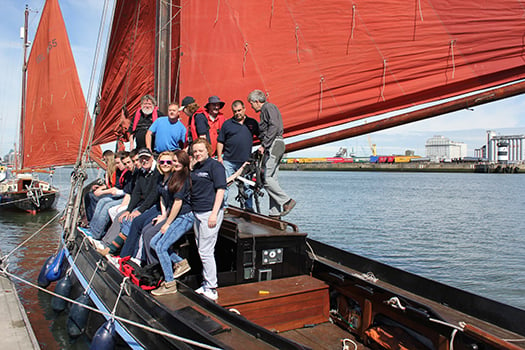
Junior Gaffers from Cork and Senior Gaffers from Dublin aboard the Naomh Cronan Photo: John Galloway
In all, it's an entertaining balance between an outing to Dublin, a chance to learn in a fun environment, and a real opportunity to demonstrate that practical skills have been well and truly acquired. And before somebody is driven to send in a rude comment after seeing these two photos of last year's Youth Sailing Project course, I hasten to assure you that when they do go sailing, everyone wears a lifejacket.
Marine Minister Forecasts Wooden Boat Building Revival
#woodenboat – Marine Minister Simon Coveney is confident that wooden boat building in Ireland is going to be revived writes Tom MacSweeney.
Traditional skills have been lost and there are fears that they will disappear forever, but the Minister sounds a confident note about preserving them on the current edition of my maritime programme, THIS ISLAND NATION.
"This project is going to reinvigorate wooden boat building in Ireland again. It is going to open a new chapter for us," he says. "Hopefully multiple ports around the country will be able to build projects like this in the future. We still have great skill sets of wooden boat building available to us in Ireland which we must not lose. It is projects like this that will keep them alive and encourage a new young generation."
I recorded Mr.Coveney at Liam Hegarty's boatyard at Oldcourt near Skibbereen where the Ilen, the last traditional sailing boat of its kind, is being restored. It is the boat which the legendary Conor O'Brien had built for the Falkland Islanders who so admired his previous vessel, Saoirse, when he sailed it into those islands during his round-the-world voyage in 1923-25. Liam Hegarty's yard at Oldcourt on a bend of the road from Skibbereen to Baltimore in West Cork is one of the few remaining that specialises in wooden boat building.
The Falklanders asked O'Brien, the first Irishman to sail a round-the-world voyage to emulate the boat on which he arrived in Port Stanley. He did as they asked, having the Ilen built in Baltimore, where Saoirse was also constructed. With two Cape Clear Islanders as crew, he sailed it to the Falklands in 1926 where it worked for 70 years until Limerickman, Gary McMahon, had it brought back to Ireland in 1997:
I was the only reporter on the quayside in Dublin when it was landed there from the deck of a cargo ship, looking every bit her age of 71 years at the time. So it was a great feeling to stand on her deck in Liam Hegarty's boatshed where the restoration work has been carried out, in conjunction with the AK Ilen boat building school, initiated by Gary McMahon, the driving force of the project Such a change from the condition in which I had seen her in the Dublin docks 18 years ago.
Gary McMahon, Liam Hegarty and Minister Coveney tell the story on the programme. Gary and Liam are both confident that Ilen will be back in the water, sailing once again. She may provide opportunities for effective sail training. Several sources have provided restoration funding. More is needed for a project which, as the Minister said, can restore Ireland's resource of traditional skills.
Also on the programme you can hear the story of a submarine which sank not once, but twice, which will make you wonder whether superstition about changing the names of boats is correct. And did you know that the Dubs beat the Kingdom ... Not in football, but fishing...?
You can hear more by listening to THIS ISLAND NATION above.
New Lease of Life for Vintage Wooden Boats Is a Maritime Highlight
#woodenboats – It's an interesting time for old wooden boats. They may be traditional craft, or classics, or simply ordinary timber boats which have reached a stage in life where they need serious and special attention. Whatever the circumstances, it's clear that their situation strikes a chord with sailors everywhere. And when there's good news about a restoration, it heartens the maritime community to know that worthwhile plans are being implemented. W M Nixon takes us on a tour.
The maritime highlight of this past week was down in the far southwest, at the ceremony in Liam Hegarty's boatyard at Oldcourt above Baltimore on the River Ilen when the "whiskey plank" was fastened in place to complete the hull re-build of the 1926 Conor O'Brien 56ft trading ketch Ilen. It has been a long haul since Ilen was brought back to Ireland from her working area in the Falkland Islands in 1997. Yet somehow, despite all sorts of problems of which the economic recession was only one, the Ilen really is starting to look ship-shape again.
Then in another part of the country, the word had come through that one of the Belfast Lough 27ft S Class sloops, twenty of which were built on the shores of Ballyholme Bay between 1946 and 1963, was facing extinction in a corner of County Louth. The news resulted in a flurry of photos on the Afloat.ie website spurred on by the indefatigable Pat Murphy, and soon the Sorona found herself a new home in a yard in Newry.
There, the story is that she'll be sharing space with the vintage ketch Silvery Light, a substantial vessel built in 1884 on the beach at St Ives in Cornwall to be a herring drifter, and now undergoing a much-needed restoration in Newry after being brought by new owners into Carlingford Lough last Autumn.
Sorona may have been only 52 years old. But her deteriorating condition was a reminder that the climate of Ireland and the seas around us can be merciless to a wooden vessel unless - whether deliberately or by happy accident - the boat is stored in a timber-friendly sheltered environment which is not too hot or cold, nor excessively wet or dry.
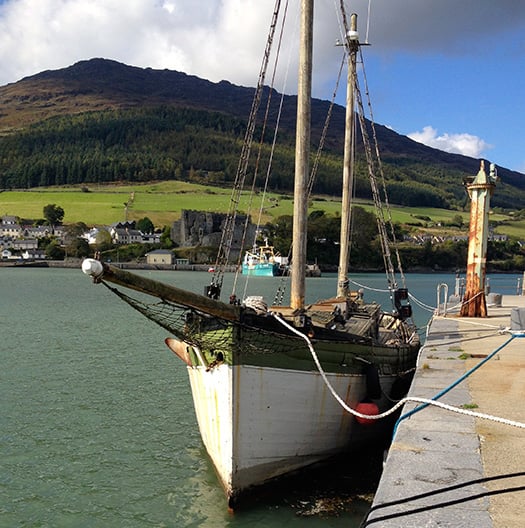 A formidable restoration challenge. The 1884-built ketch Silvery Light – seen here in Carlingford last October – will be undergoing restoration in Newry. Photo: Peter Redmond
A formidable restoration challenge. The 1884-built ketch Silvery Light – seen here in Carlingford last October – will be undergoing restoration in Newry. Photo: Peter Redmond
In the middle of the Irish Sea in the ancient capital of the Isle of Man at Castletown, the 26ft schooner Peggy had survived remarkably well in her harbourside "boat cellar" under Bridge House. In fact, her survival was miraculous, as Peggy was built in 1789, making her probably the oldest yacht in the world. But in recent years, it became clear that a major conservation project was going to be needed to preserve this unique craft.
And just three weeks ago, for the first time in 180 years, the Peggy was removed from her private space in a skilled operation. She is now safely ensconced in a specially prepared conservation workshop in the island's modern capital of Douglas, where it is anticipated the painstaking process of preserving this exceptional gem of maritime heritage could take five years.
Once you have the ideal conditions of micro-climate in place for doing the job, conservation is a long haul, a project of infinite patience. One of the best examples of how it can be done successfully is in Dublin with the Asgard, now on display in Collins Barracks. John Kearon, who learned his shipwright skills in Arklow and then broadened them to include historical work with the Liverpool Maritime Museum, was to lead the team working on this from 2007 until its completion in 2012.
The result is a multi-value display, as the 1905-built Asgard has her place in Irish history through the 1914 gun-running to Howth, she is also totally associated with Erskine Childers which takes us, among other elements in a complex history, into the world of his 1903 best-selling espionage novel The Riddle of the Sands, and she is a marvellous example of the work of the great designer-builder Colin Archer of Norway in creating a very able seagoing yacht of the era, one of the best cruising vessels of her time.
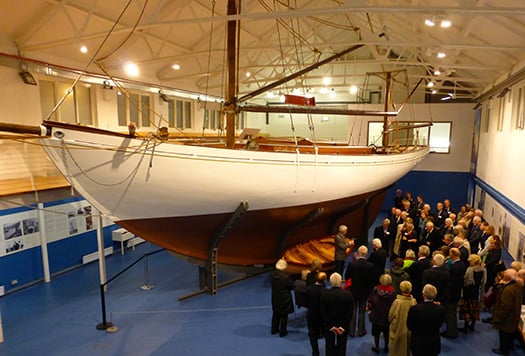
The Asgard in Collins Barracks is a fine example of conservation. A group of Erskine Childers enthusiasts from the Royal Cruising Club is seen here listening intently to a talk by conservator John Kearon about the vessel and the preservation work done with her by his team. Throughout her ownership by Erskine & Molly Childers from 1905, Asgard played a prominent role in the activities of the RCC, and in 1913 their friend Gordon Shepherd was awarded the club's historic Challenge Cup for his remarkable Autumn cruise with Asgard from Norway to North Wales via the Shetland Islands and the Hebrides. Photo: W M Nixon
In her day, the little Peggy was also something of a unique star. Though based in the Isle of Man and most active during the 1890s, she was never in Ireland. Had she been seen on the Irish coast, it would probably have been because she'd been captured by the privateers and smugglers of Rush in North Dublin, who were the capture and contraband industry leaders of their day.
So when Peggy's owner George Quayle (1751-1835) took her "abroad", it was prudently to northern England to race successfully against a small fleet of early yachts on Windermere in the Lake District, though we can be sure that if the men of Rush had come anywhere near him, Quayle would have put up a gallant fight, as Peggy was an armed yacht with miniature cannons which most certainly weren't toys.
But it's the realization that Quayle was active at sea with the Peggy in the years after Luke Ryan of Rush was at his busiest, yet before James Mathews of the same port was at his most active, which helps us to grasp her historical significance. She was sailing the Irish Sea well before the Battle of Trafalgar. But thanks to being immured for a hundred years in her boat cellar after George Quayle died in 1835, this small but significant vessel has survived to become something of extraordinary value today.
Her inevitable deterioration was accelerating in recent years because of mineralization of her fastenings, which were not only consuming themselves, but were damaging all the timber about them. However, her conservation was not something to be undertaken lightly. The provision of a proper facility had to be organised, and then the liftout, clear over the tops of the harbourside houses, had to be planned within inches.
It was all relatively new territory for many of those involved, with much preparatory work. So what had originally been planned as an Autumn 2014 lift finally became possible in late January 2015, just when the weather went to pot, with one gale after another making for impossible conditions. But then one cold Thursday morning at the end of January, the wind maps suggested the arrival of a brief lull in the northwest gales. It arrived exactly on time on a sunny day suggestive of early Spring, and gently but steadily the Peggy emerged.
As Chris Weeks of Manx Heritage remarked as he watched from the parapet above George Quayle's little boat dock, the one thing
they didn't want to hear was any creaking or groaning. If the special lifting cradle was doing its job, the Peggy would rise from her nest of 180 years in perfect silence. And that's exactly how it went, with the lift done in two stages as they were working in very confined streets and spaces.
{youtube}-UyKjwdAhgw{/youtube}
Of course, after all the fuss those of us in the Peggy Appreciation Society have been making for years, when she did finally come into the open the inevitable reaction was: "But she's very small". What on earth did they expect? Something like Nelson's Victory rising up over the old houses of Castletown? How many times do we have to reiterate that she's only 26ft in overall length, just a foot longer overall than a Folkboat, though with greater bulk and a longer waterline.
What her emergence did properly reveal, for the first time in all those 180 years, is just how much the Peggy is a vessel of her era. This is indeed a ship – albeit a miniature one – of the 18th Century. But she's an 18th Century high performance mini-ship nevertheless – this is undoubtedly a vessel well worth conserving.
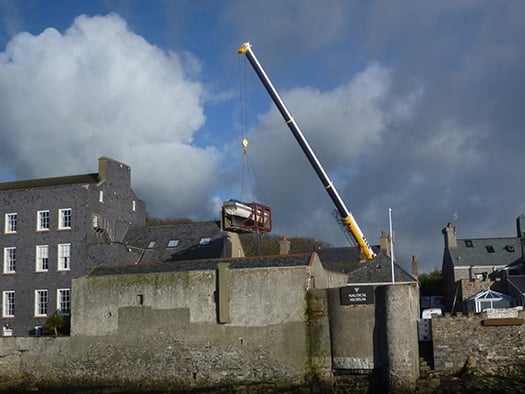
Peggy aloft. The newest crane in the Isle of Man lifts the oldest boat in the Isle of Man. Photo: Michael Kneale
So the day went well. And for those with a technical interest in such things, the word is that the delicate lifting of the oldest boat in the Isle of Man was done by the newest crane on the Isle of Man, a Japanese made Tadano recently delivered (for a cool £550,000) to Mann Crane Hire whose boss Chris Barnes was understandably proud of the smooth work put in by his supervisor Colin Fitzgerald and crane driver David Hooper.
Thanks to their good work everyone was able, for the first time in 180 years, to fully admire and savour the Peggy's lines. To the uninitiated, she may look like just another 26ft clinker-built boat. But for connoisseurs, she's living history with a stylish hull, as she has the most gorgeous hollow waterlines forward, and a sweet run aft – George Quayle had himself a flyer.
 To a casual observer, this may look like just another 26ft clinker-built boat. But for connoisseurs, this is a genuine miniature of a 17th Century ship - the Peggy is very special. Photo: Michael Kneale
To a casual observer, this may look like just another 26ft clinker-built boat. But for connoisseurs, this is a genuine miniature of a 17th Century ship - the Peggy is very special. Photo: Michael Kneale
So it's a bit sad that, as with the Asgard, we have to accept that conservation means the Peggy will never sail again. But thanks to John Kearon's painstaking work, the plans of Asgard as she was originally in 1905 are readily available for any group wishing to build a seagoing replica. Stranger things have happened. And as the Peggy is of such a manageable size, it's even more likely that a new seagoing replica of the little Manx schooner will appear some time, and maybe sooner rather than later. After all, she'd be much the same size as the "new" Shannon hooker Sally O'Keeffe down in Kilrush, which is absolutely on target as a community maritime project.
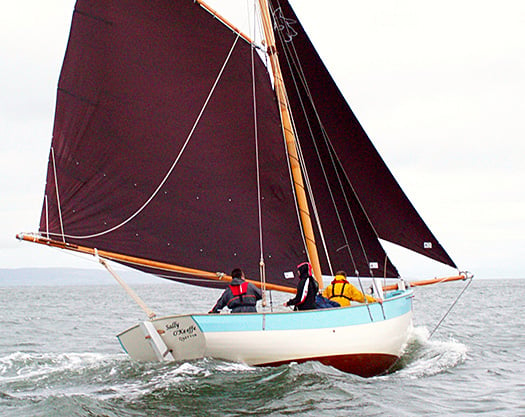
The 2012-built Sally O'Keeffe on the Shannon Estuary is much the same size as the Peggy of Castletown.
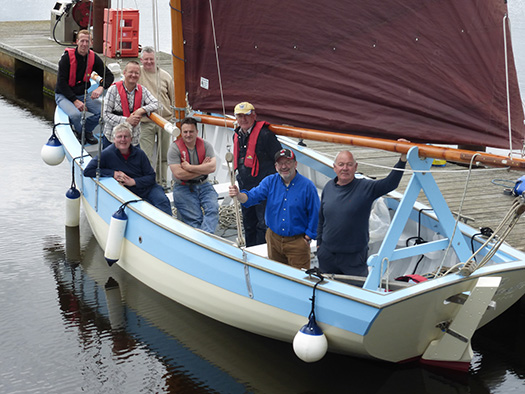 A genuine community project. Some of the team who built Sally O'Keeffe in Querrin aboard the boat in Kilrush with lead builder Steve Morris second left in the trio up forward. Photo: W M Nixon
A genuine community project. Some of the team who built Sally O'Keeffe in Querrin aboard the boat in Kilrush with lead builder Steve Morris second left in the trio up forward. Photo: W M Nixon
Nevertheless after immersing ourselves in the dusty academic topic of proper boat conservation, it's like a breath of fresh air to consider the Ilen, for she will definitely sail again. Tom MacSweeney of this parish was at the ceremony, so we'll defer to himself for his detailed report on the occasion in the fullness of time. But just from looking at the photos, you can get some idea of the quality of the workmanship that Gary MacMahon and his team from the Ilen Trust and Boatbuilding School in Limerick are getting from Liam Hegarty and his shipwrights at Oldcourt.
The pure style of the new planking is a joy to behold. And as for the use of classic bronze spikes for the fastenings, they're a work of the craftsman's art in themselves. Gary MacMahon brought one along to the recent Sail Training Ireland Annual Awards ceremony in the Mansion House in Dublin, and in that setting and on that occasion, you couldn't help but think that if our impoverished nation had been able to utilise bronze fastenings of this standard in Asgard II when building her in the late 1970s, rather than the galvanized steel fastenings that had to be used, then our beloved sail training brigantine might still be sailing today.
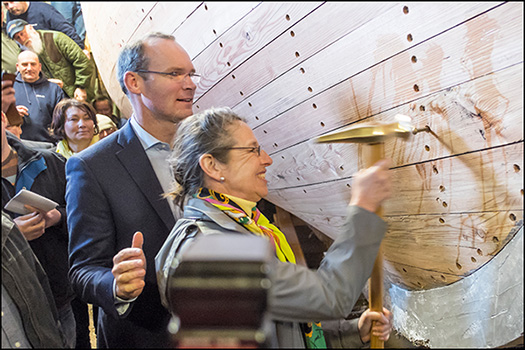
Quality work at every level. The superb workmanship on the Ilen restoration by Liam Hegarty is much in evidence as Minister for the Marine Simon Coveney supports Kate Jarvey of the Ruth Lilly Philanthropic Trust as she drives the bronze fastening to complete the "whiskey plank". Photo: Kevin O'Farrell
But Asgard II is long gone, and so too is Conor O'Brien's Saoirse, the 42ft Baltimore-built ketch in which the Limerick sailor made his extraordinary voyage round the word south of the Great Capes in 1922-25. Thus Ilen is the only tangible link to that remarkable and very historic achievement. For those who enjoy looking at line drawings of boats (not everyone does - there are some who claim that such technical stuff makes them feel "disenfranchised"), it's intriguing to compare the lines of the 42ft Saoirse and the 56ft Ilen.
They're clearly sisters, but you'll note that the Ilen people have made sure that Tom Moynihan of Baltimore is given a significant amount of credit for the design, for down in West Cork they'll tell you that for all that Conor O'Brien was an architect by profession, it took Tom Moynihan's skills to turn his rough concept sketches into vessels capable of sailing so ably across the oceans.

The lines of Ilen as taken off the hull by laser scanner
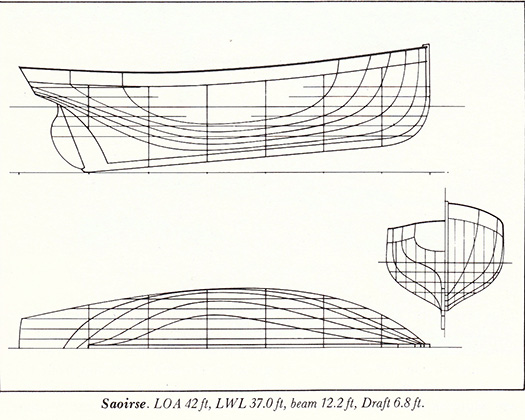
The hull lines of Saoirse as interpreted by Myles Stapleton (designer of Sally O'Keeffe) from basic drawings by Conor O'Brien
An Irish designer who didn't need anyone's help to make his creations look like proper boats was John B Kearney (1879-1967). He may have started his working life as a boy apprentice at Murphy's Boatyard in Ringsend in the early 1890s, while his working life was to be spent with Dublin Port & Docks where he rose to be Superintendent of Engineering Works. But his lifetime ambition was always to be a yacht designer, he trained and studied for it in his very limited spare time from boyhood, and then he worked at it throughout his long retirement. When he finally died at the age of 87, his gravestone in Glasnevin says it all, as it simply reads: John Breslin Kearney.....Yacht Designer. Beloved and respected by all that knew him.
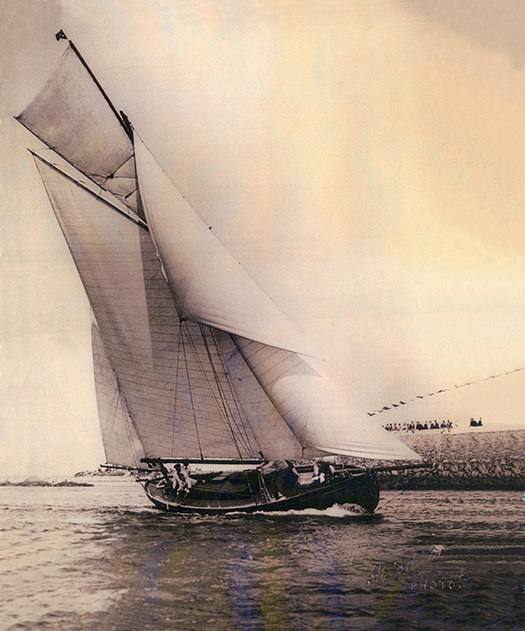
Mavis in her element under Skipper Kearney's command, on her way to winning Skerries Regatta in 1928
For everyone who sailed with him in his many successful cruises and races, he was always Skipper Kearney, and Skipper Kearney's finest creation was the 38ft yawl Mavis which he designed and built himself in Ringsend in 1923-25. Mavis went to America in 1956, and from time to time we've mentioned the continuing process of restoration on her in Camden, Maine, which has been going on for quite a few years now. It has been a lengthy process as owner/restorer Ron Hawkins has to take time out now and again to earn extra funds as a shipwright in order to to keep the Mavis restoration show on the road.
But it's getting there at last. So much so, indeed, that having given the hull of Mavis its first coat of paint in more than twenty years just a couple of weeks ago, Ron and his partner Denise Pukas are now talking of a re-launch date of July 4th 2015 for the restored ship, this treasure of the Irish yacht designer's art and craft.

The quality of workmanship in the restoration of Mavis is clearly displayed. Note how John B Kearney skillfully carried the beam well aft in order to provide a wide and comfortable afterdeck despite incorporating a canoe stern. Photo: Denise Pukas
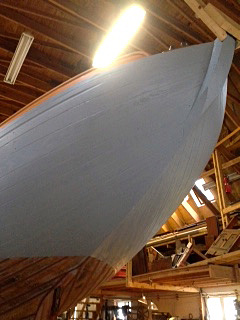
The canoe stern on Mavis with its first coat of fresh paint in 20 years. Here we can appreciate again how John Kearney managed to have an elegant canoe stern while providing plenty of deck space aft. Photo: Denise Pukas
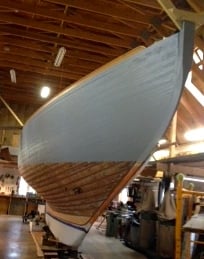
The most famous Kearney hull of all begins to emerge from restoration. It is hoped to re-launch Mavis on July 4th 2015. Photo: Denise Pukas
It would be pleasant to keep this week's commentary on a good news theme right through to the end, but the various emails about saving the Sorona from an untimely end in County Louth brought the information that there are skilled boatbuilders in places like Arklow who are looking for boats needing restoration - not as a commercial venture, but rather as a worthwhile private project.
The secret of it all is surely being able to assess if a particular boat is too far gone to be within your restoration capabilities and resources. Be that as it may, it was sadly ironic to reflect that within yards of the bright and cheerful festival which celebrated the final plank being installed on the Ilen, there's a derelict little boat which would be very rewarding to restore, but it's likely that she's so far gone it's actually a re-build you'd be contemplating.
We're talking of the Englyn, the Harrison Butler-designed 26-footer which came up on the radar last May when were discussing the new 31ft Harrison Butler-designed Khamseen class which Steve Morris, lead builder of the Sally O'Keeffe, is constructing beside his house near Kilrush. But while Steve's boat is starting to look very healthy indeed, sad little Englyn is anything but as she lies abandoned within yards of the Old Cornstore where Ilen is being so beautifully re-born.
Part of the problem in getting anyone interested in the Englyn – which was built in 1934 in Southampton – is that her only link to Ireland was through various owners later in her life. Yet in her day she was considered a classic, so much so that when Eric Hiscock's defining book Cruising Under Sail was published in 1950, Englyn was one of the featured designs. And as the designer Harrison Butler was professionally an ophthalmic surgeon who put heart and soul into everything he did, when Hiscock asked him for the plans he went to infinite pains to bring them to life as a vision of a proper little cruising yacht, even to having a trussed chicken shown in the meat locker.
Over and above that, when looking at Englyn's plans it's not unreasonable to think that, 25 years before Lyle Hess was starting to design his first characterful boats, Harrison Butler was thinking along much the same lines. And he had the boats afloat to prove it.
But that piece of thinking is another day's work. For now, give us a moment of your time to consider the drawings of Englyn as she was in her prime. Then pause briefly to consider sadly how she looked last Monday as Ilen was re-born nearby. And then let's hear it from those who say they're looking for a worthwhile restoration project.

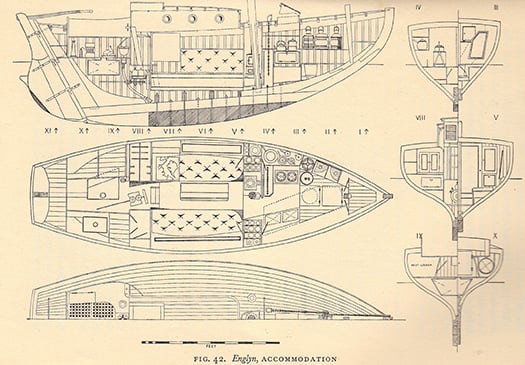
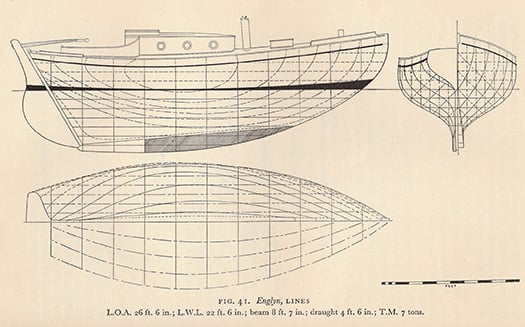
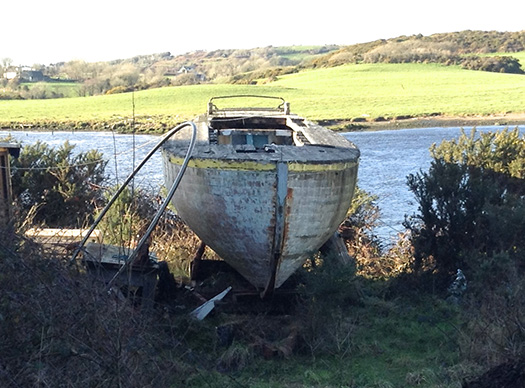
Englyn as she was last Monday at Oldcourt, as the re-birth of Ilen was being celebrated nearby. Photo: John Wolfe





























